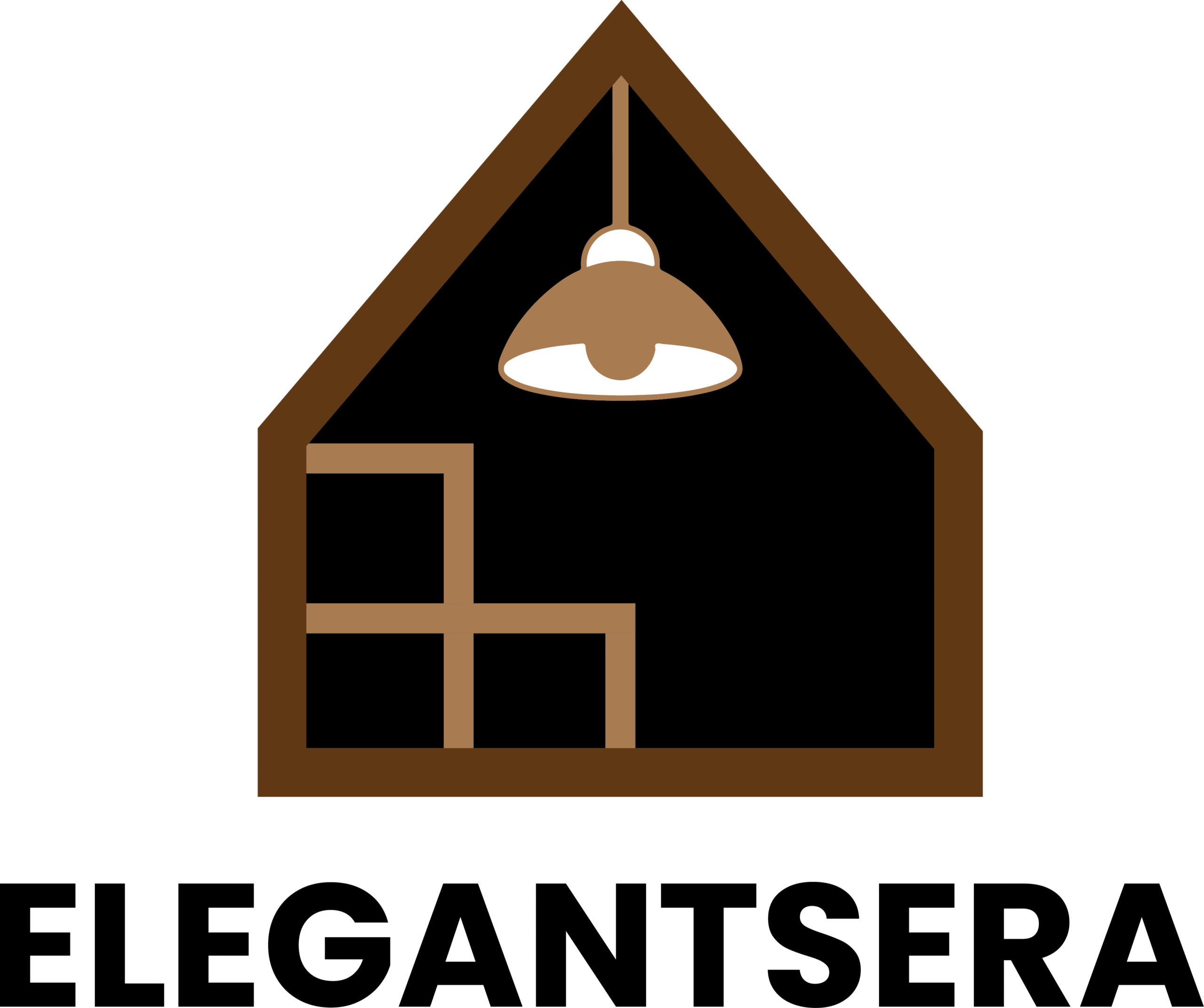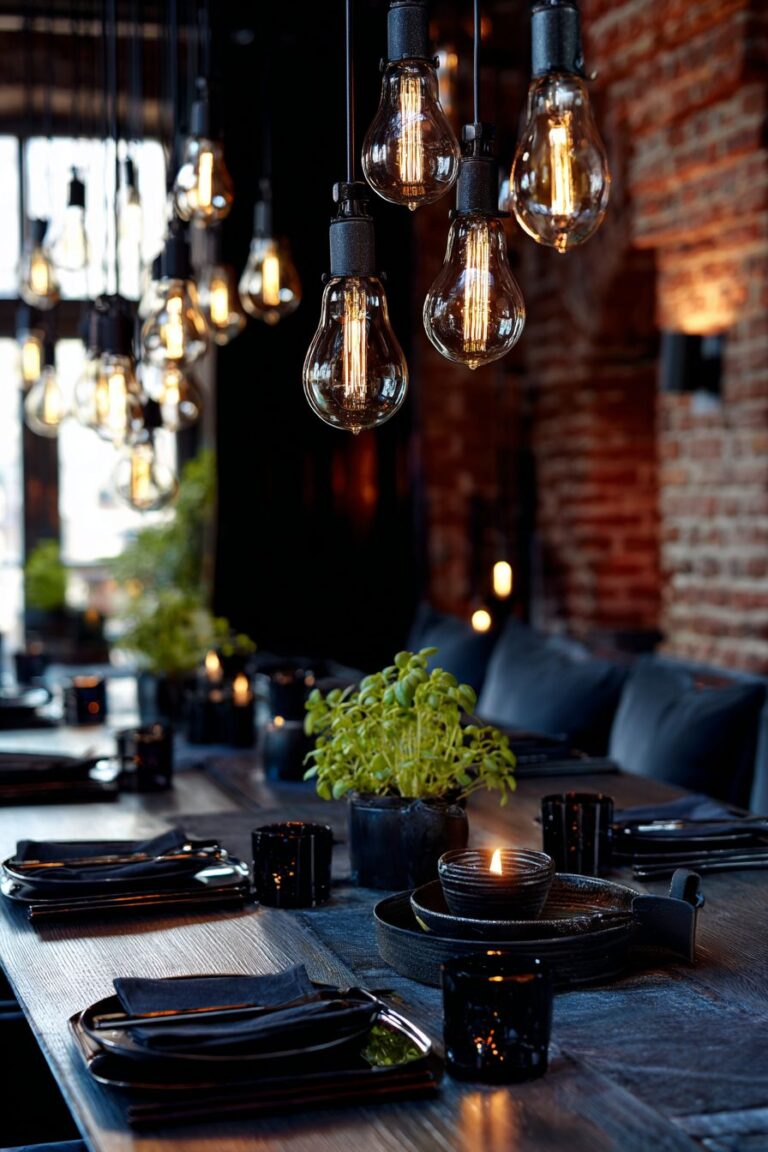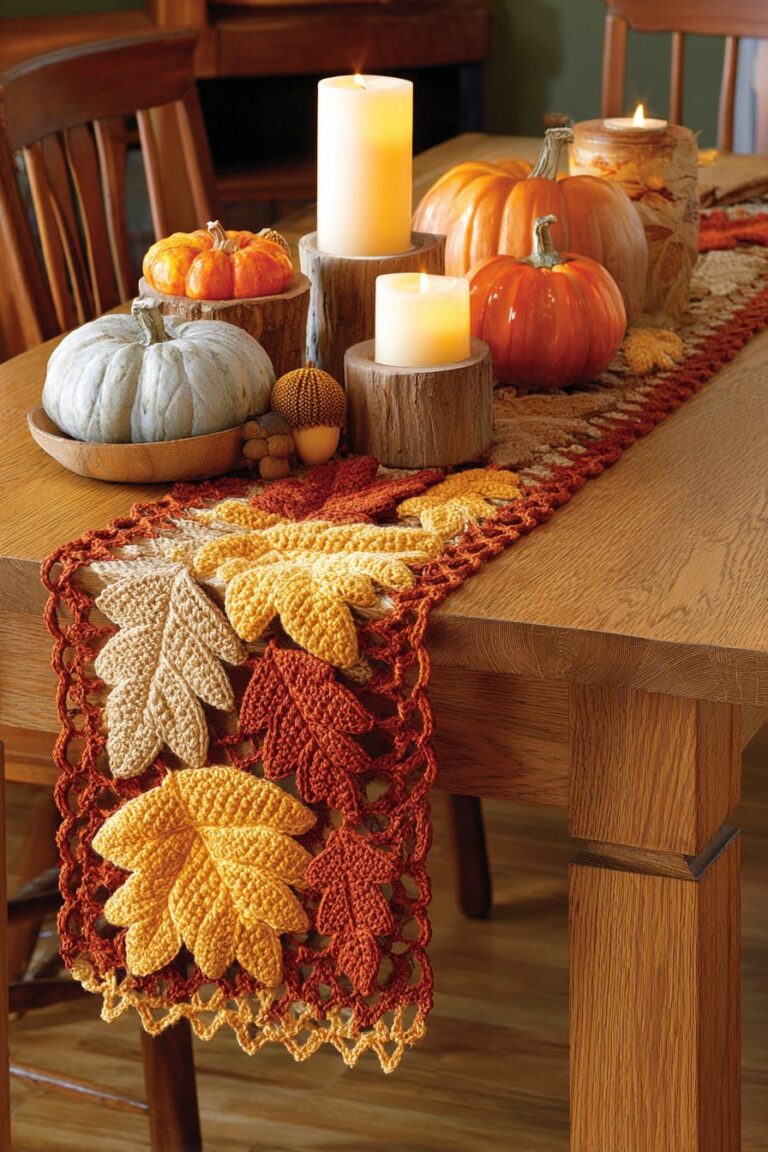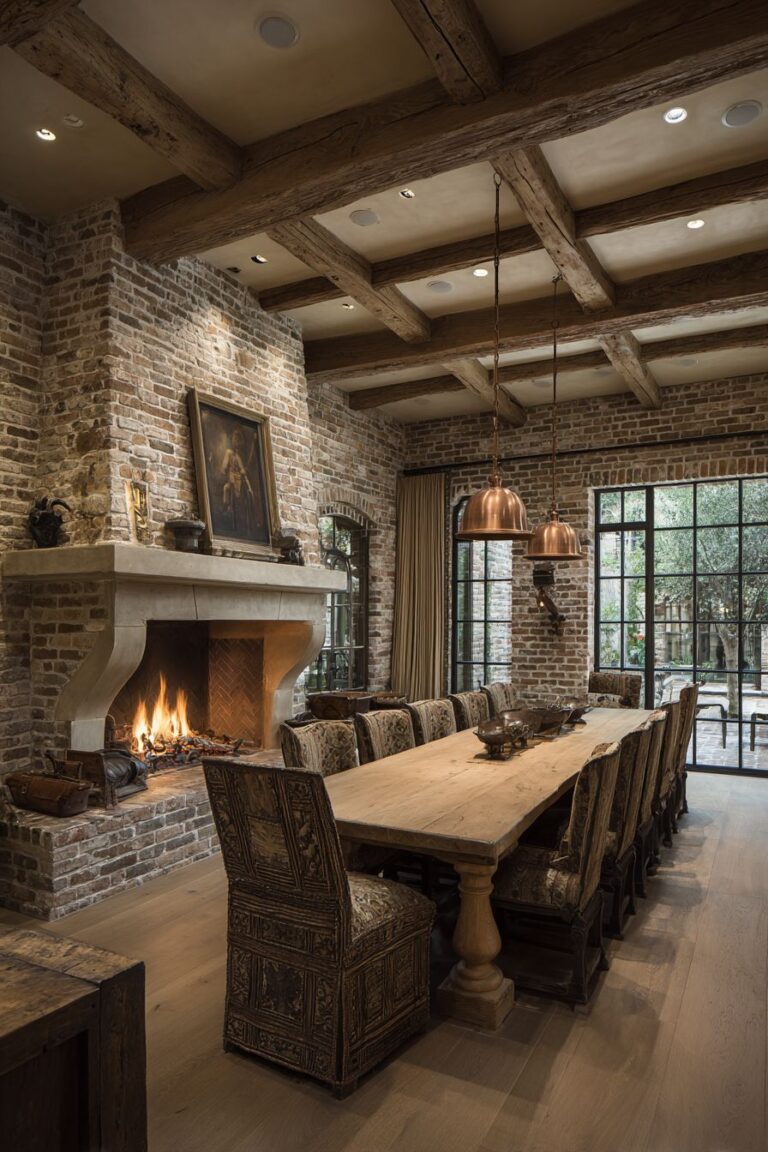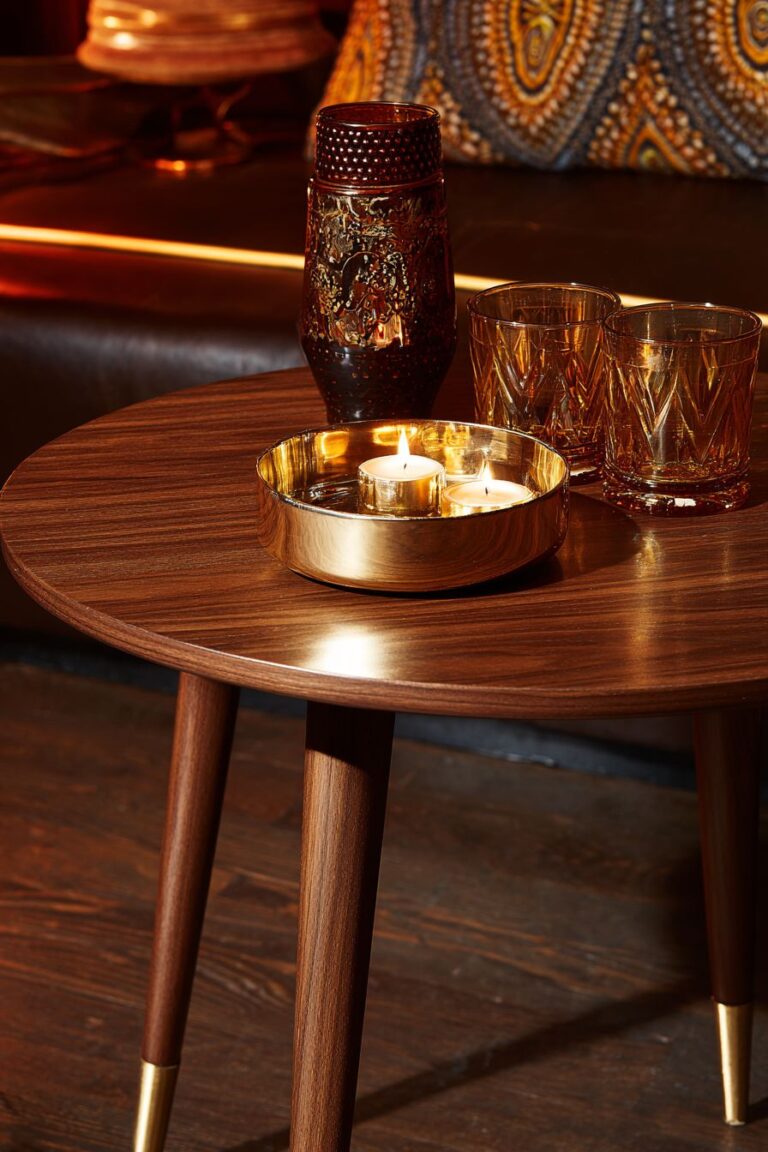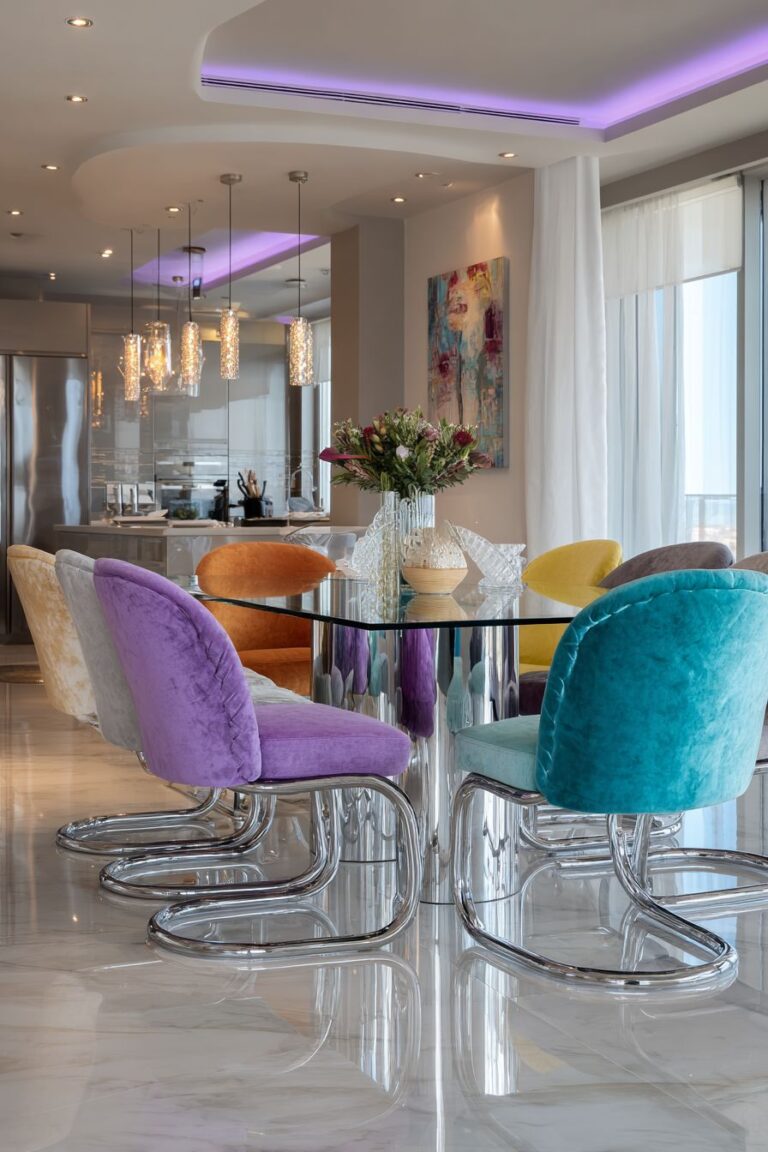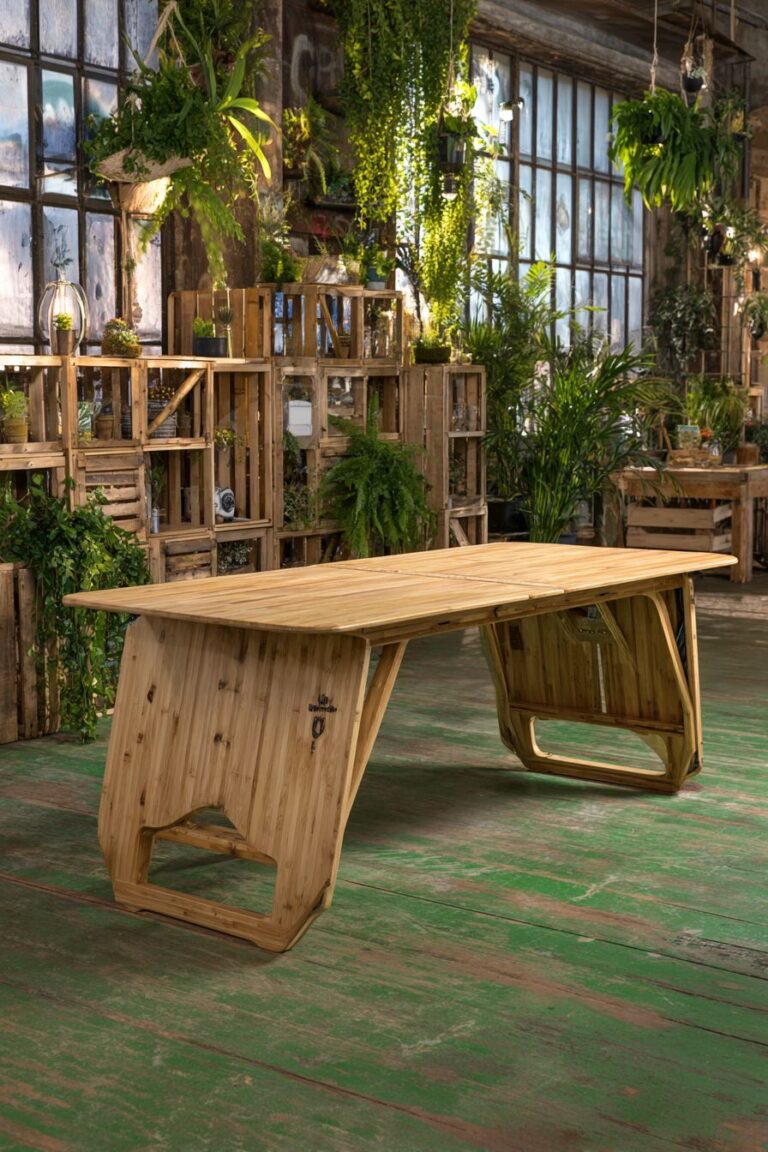19+ Retro Dining Room Ideas: Mid-Century Modern Designs
The dining room serves as the heart of the home, where families gather to share meals, conversations, and create lasting memories. In the realm of interior design, few styles capture the essence of sophisticated functionality quite like retro dining rooms. These spaces, rooted in the mid-century modern movement of the 1950s through 1970s, continue to captivate homeowners with their clean lines, bold colors, and innovative materials that perfectly balance form and function.
The retro dining room aesthetic represents more than just nostalgic appeal—it embodies a design philosophy that celebrates simplicity, quality craftsmanship, and the seamless integration of indoor and outdoor living. From the iconic Eames chairs to sleek teak credenzas, these spaces showcase furniture pieces that have become timeless classics, proving that good design transcends decades. The careful selection of materials like walnut, teak, chrome, and molded plastics creates environments that feel both sophisticated and approachably warm.
This comprehensive guide explores twenty distinctive retro dining room concepts, each highlighting different aspects of mid-century modern design. Whether you’re drawn to the geometric patterns of atomic-age wallpapers, the sculptural beauty of tulip tables, or the rich warmth of rosewood finishes, these designs offer inspiration for creating spaces that honor the past while remaining perfectly relevant for contemporary living.
1. Mid-Century Modern Walnut Elegance with Eames Influence

The quintessential retro dining room begins with a stunning mid-century modern walnut dining table featuring distinctive hairpin legs that exemplify the era’s love for clean, structural elements. The warm, rich grain of the walnut creates a striking contrast against the sleek metal supports, establishing a foundation that speaks to both craftsmanship and innovation. Surrounding this centerpiece, vintage Eames-style molded plastic chairs in vibrant orange and turquoise inject personality and color into the space, demonstrating the period’s embrace of new materials and manufacturing techniques.

The geometric patterned wallpaper in warm earth tones serves as more than mere decoration—it becomes a statement piece that captures the atomic age’s fascination with molecular structures and scientific discovery. These bold patterns, often featuring interconnected circles, starbursts, or angular shapes, transform the dining room into a conversation starter while maintaining the sophisticated restraint characteristic of mid-century design. The warm earth tones ground the space, preventing the geometric elements from overwhelming the room’s serene atmosphere.
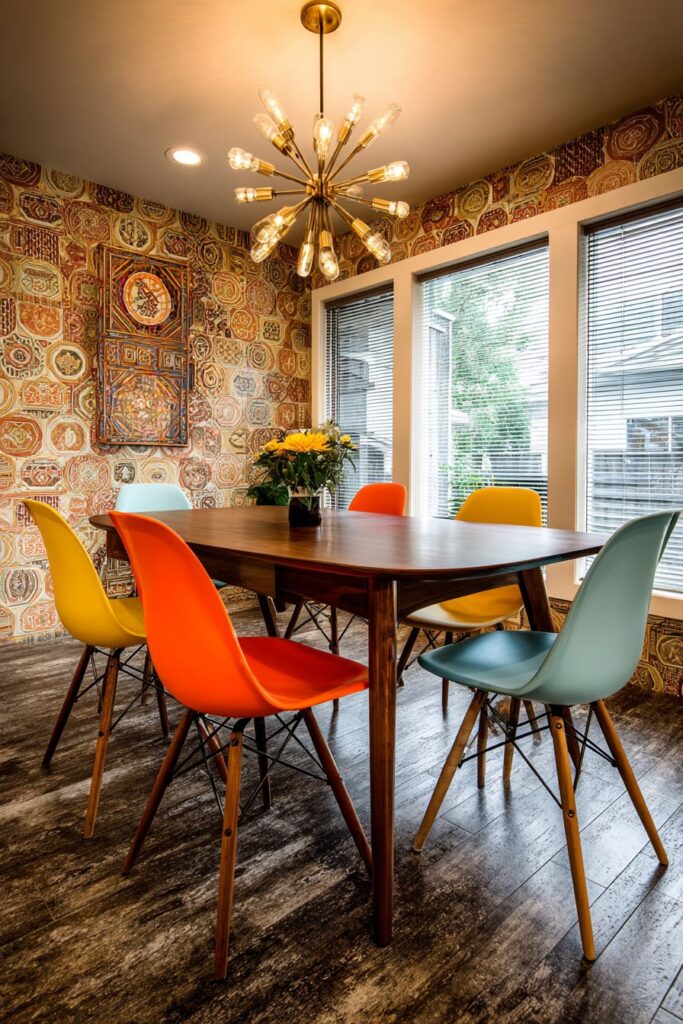
Above this carefully curated scene, a classic starburst chandelier with brass accents commands attention without dominating the space. This iconic lighting fixture, with its radiating arms and multiple bulbs, embodies the era’s optimistic vision of the future while providing practical illumination for dining. The brass accents echo the warm metallic tones found throughout mid-century design, creating visual continuity with other elements in the room.

Key Design Tips:
- Choose furniture with clean lines and minimal ornamentation to maintain authentic mid-century aesthetics
- Incorporate bold colors through seating to add personality without overwhelming the space
- Select geometric wallpaper patterns that reflect atomic age motifs and scientific inspiration
- Use starburst or sputnik-style lighting fixtures to create dramatic focal points
- Balance warm wood tones with cooler metallic accents for visual harmony
2. Danish Teak Sophistication with Tulip Table Grace
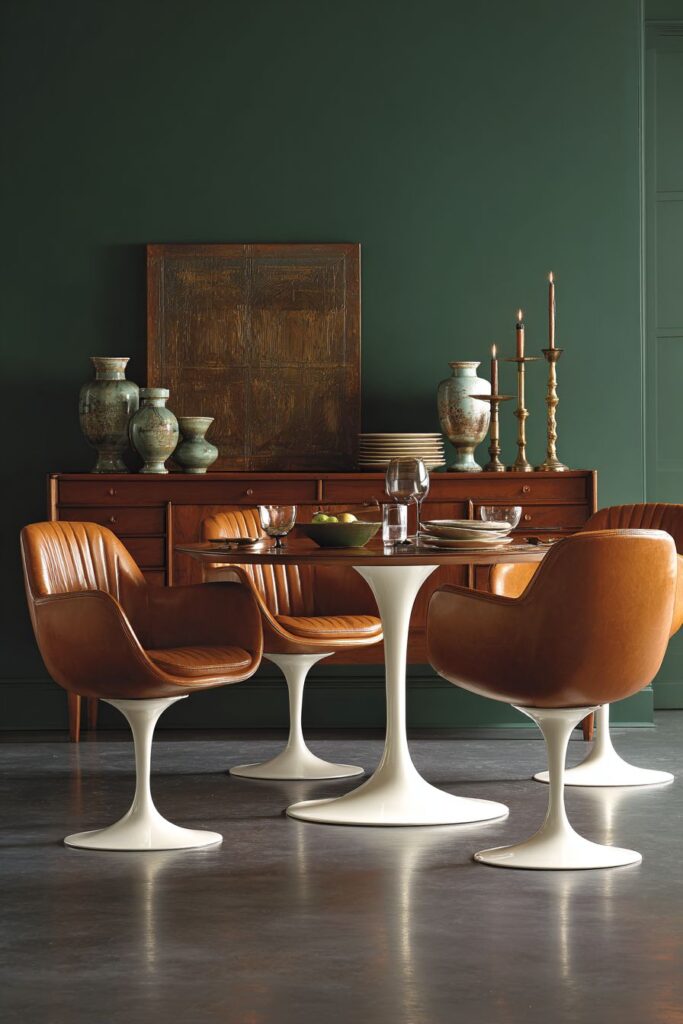
The Danish modern influence shines brilliantly in this retro dining room, where a sleek teak credenza serves as both functional storage and artistic display. The credenza’s clean lines and distinctive hardware showcase the Danish commitment to functional beauty, while its rich teak finish adds warmth and natural character to the space. Vintage ceramic dishes and brass candlesticks displayed on its surface create vignettes that speak to the era’s appreciation for both everyday objects and special occasion pieces.
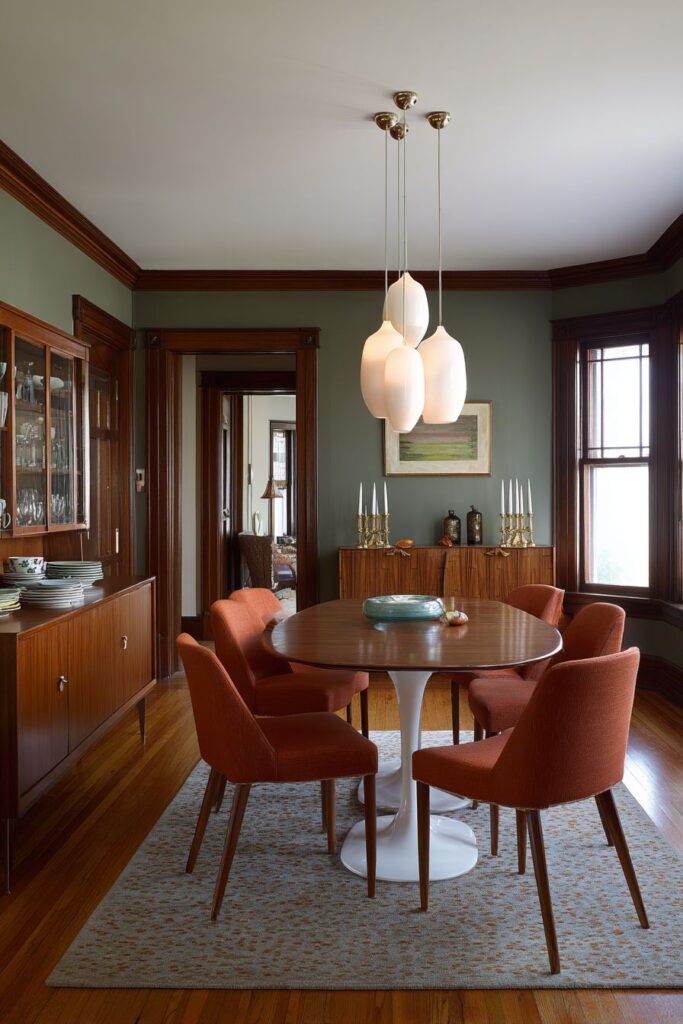
At the room’s center, a round tulip-style table with its iconic white base and wood top represents one of the most recognizable designs of the mid-century period. This table’s sculptural pedestal base eliminates the need for traditional legs, creating an sense of lightness that makes the dining area feel more spacious. The combination of the white base with a warm wood top exemplifies the period’s mastery of mixed materials, creating visual interest through contrast while maintaining overall cohesion.
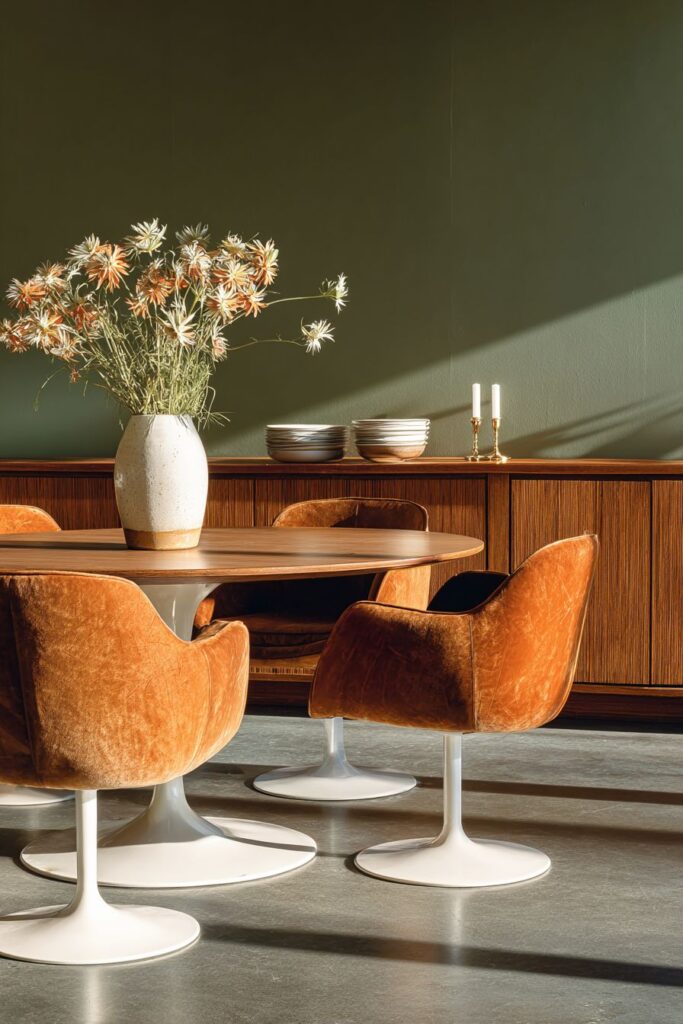
The upholstered swivel chairs in burnt orange vinyl surrounding the table demonstrate the era’s innovative approach to seating. These chairs offer both comfort and functionality, with their swivel mechanism allowing diners to easily turn toward conversation partners or adjust their position without moving the chair. The burnt orange vinyl, a popular choice during the retro period, adds a bold color statement while being practical for everyday use in a dining setting.
The olive green accent wall serves as a sophisticated backdrop that complements the warm wood tones throughout the space. This color choice reflects the period’s embrace of nature-inspired hues, bringing an organic element into the carefully designed interior. The interplay between the olive green wall and the teak furniture creates a harmonious color palette that feels both grounded and sophisticated.
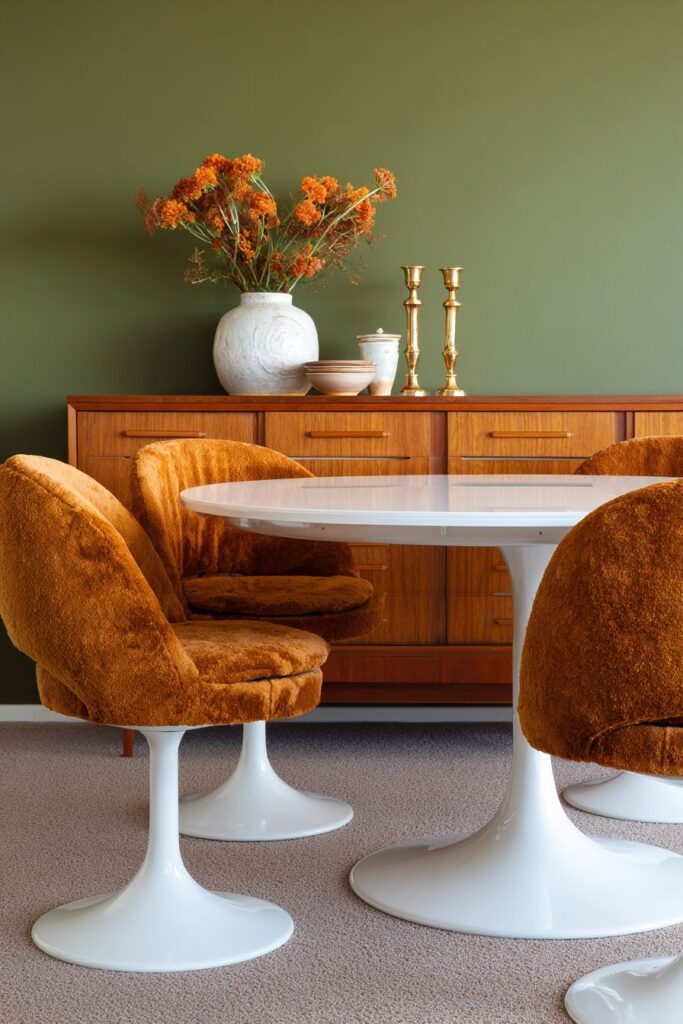
Key Design Tips:
- Invest in quality teak furniture pieces that showcase beautiful wood grain and craftsmanship
- Use tulip-style tables to create visual lightness and maximize floor space
- Choose swivel seating for added functionality and authentic mid-century appeal
- Select nature-inspired accent colors that complement warm wood tones
- Display vintage ceramics and brass accessories to enhance the authentic retro atmosphere
3. Authentic Teak Dining with Ladder-Back Character
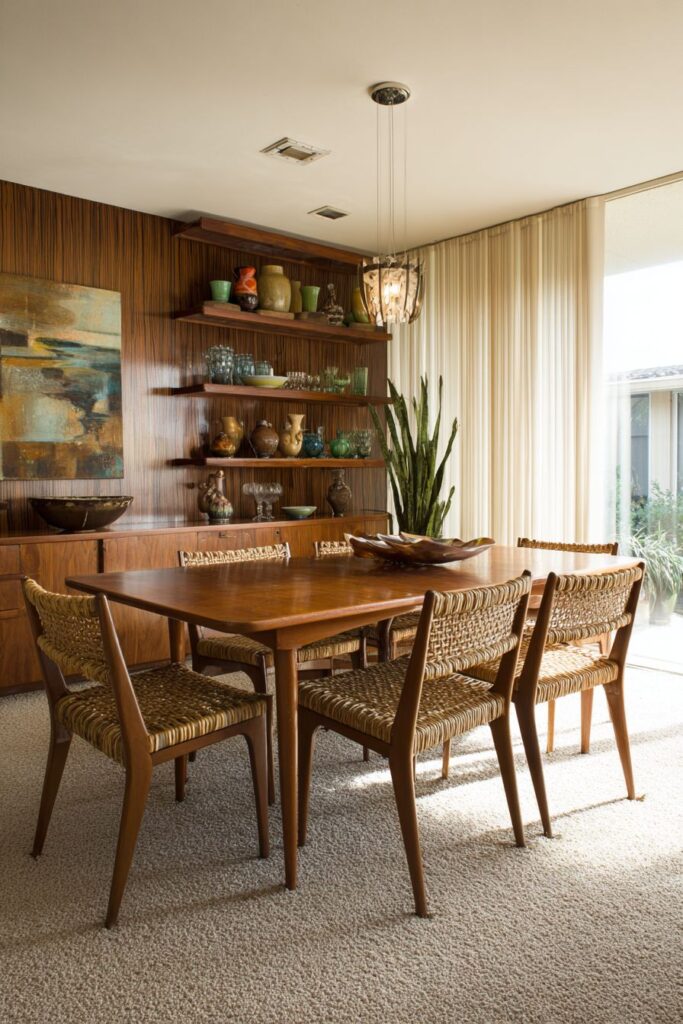
This retro dining room showcases the enduring appeal of authentic teak furniture through a rectangular dining table that exemplifies mid-century craftsmanship. The table’s clean lines and expertly tapered legs demonstrate the period’s commitment to functional elegance, while the rich teak grain provides natural beauty that improves with age. This piece serves as the room’s anchor, establishing a foundation of quality and authenticity that defines the entire space.
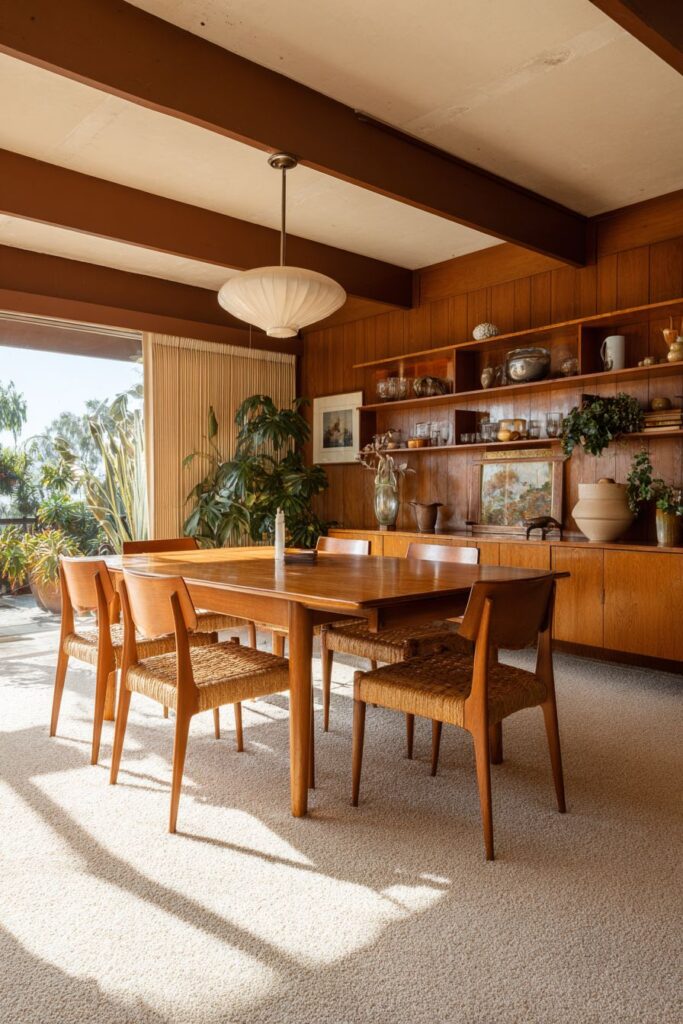
The ladder-back chairs with woven rush seats surrounding the table represent a fascinating blend of traditional craftsmanship and mid-century sensibilities. These chairs honor historical furniture-making techniques while maintaining the period’s preference for natural materials and honest construction. The rush seats provide both comfort and visual texture, adding an organic element that softens the room’s more geometric features while remaining true to the era’s aesthetic principles.
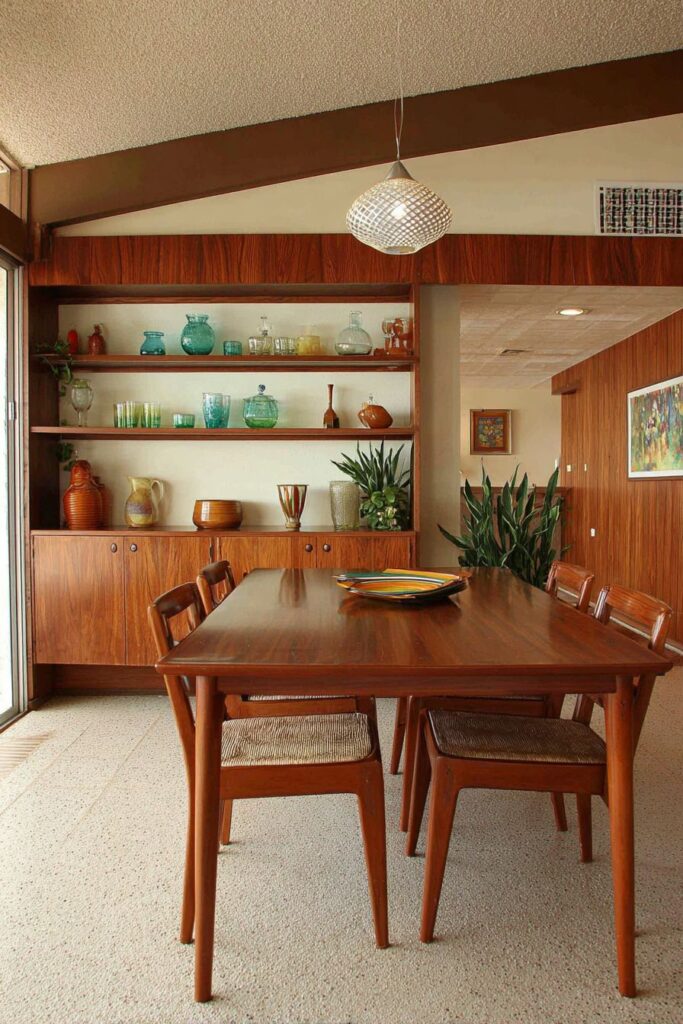
Built-in corner shelving creates an architectural element that maximizes storage while maintaining the period’s love of integrated design solutions. These shelves display vintage glassware and pottery in earth tones, creating carefully curated vignettes that serve both decorative and functional purposes. The earth-toned pottery reflects the era’s connection to natural materials and handcrafted objects, adding warmth and personality to the structured environment.
The wood paneling treatment, extending halfway up the walls with cream paint above, creates visual interest while maintaining the room’s sophisticated restraint. This two-tone approach prevents the wood from overwhelming the space while adding architectural detail that enhances the room’s mid-century character. The classic atomic-era pendant light fixture hanging centered over the table provides focused illumination while serving as a sculptural element that captures the period’s fascination with atomic and molecular forms.
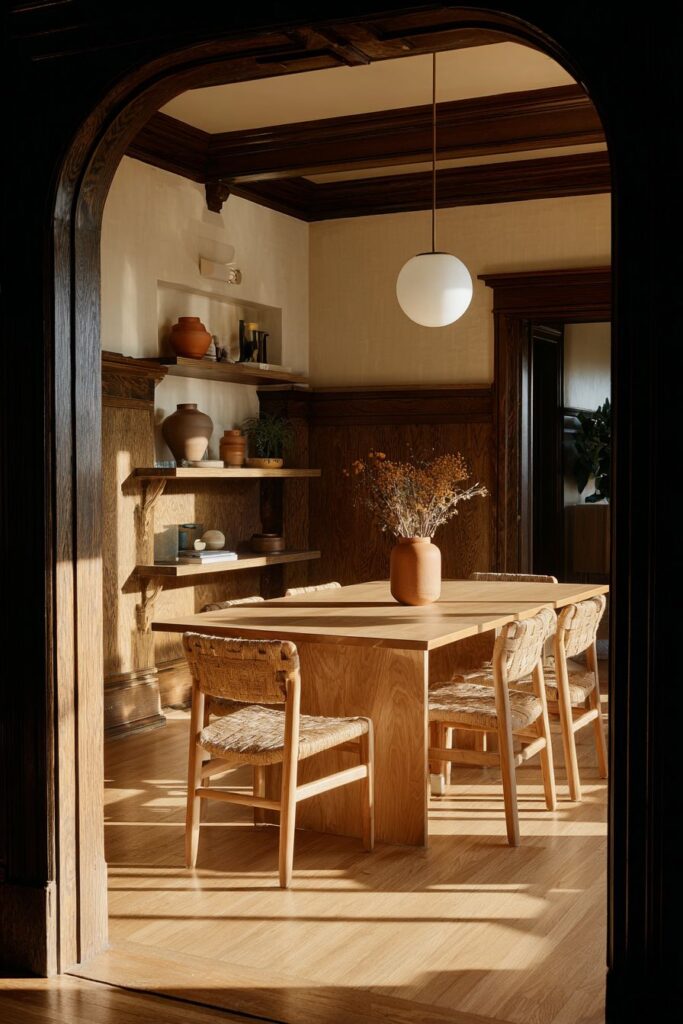
Key Design Tips:
- Choose solid teak furniture with visible wood grain for authentic mid-century appeal
- Incorporate traditional craftsmanship elements like rush seating for texture and character
- Use built-in storage solutions to maximize space while maintaining clean lines
- Create visual balance with two-tone wall treatments that prevent wood overload
- Select atomic-era lighting fixtures that double as sculptural art pieces
4. Chrome and Glass Sophistication of the Late Seventies
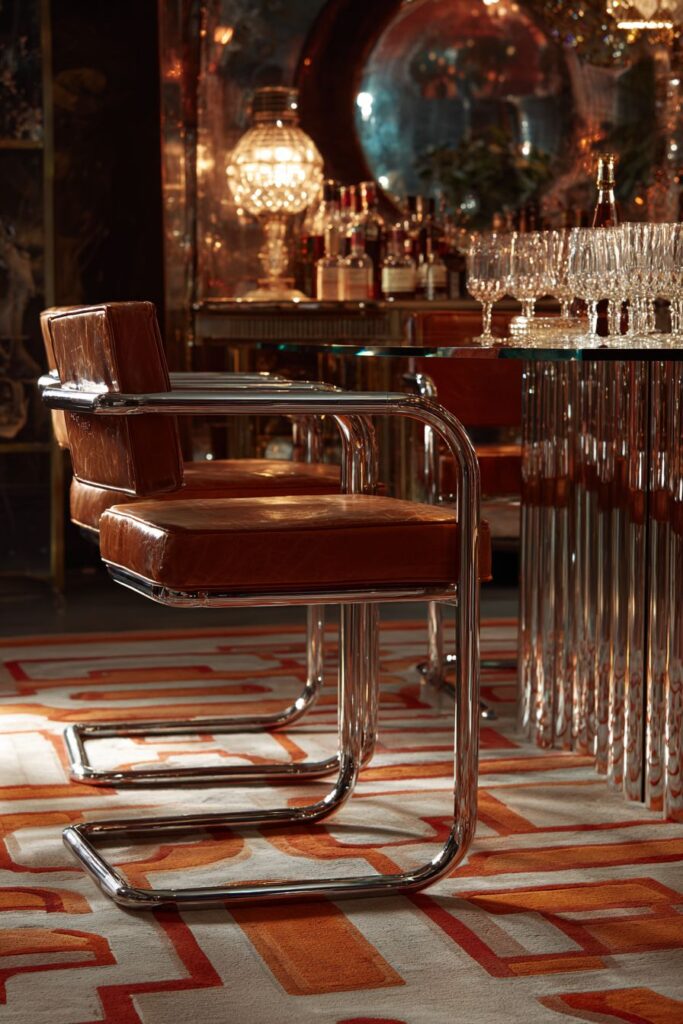
The sleek sophistication of late 1970s design comes alive in this retro dining room, where a chrome and glass dining table serves as the centerpiece of understated luxury. The table’s reflective surfaces create an interplay of light and shadow that adds dynamic visual interest throughout the day, while the chrome’s mirror-like finish amplifies natural light and makes the space feel larger and more open. This design choice reflects the period’s fascination with industrial materials adapted for residential use.
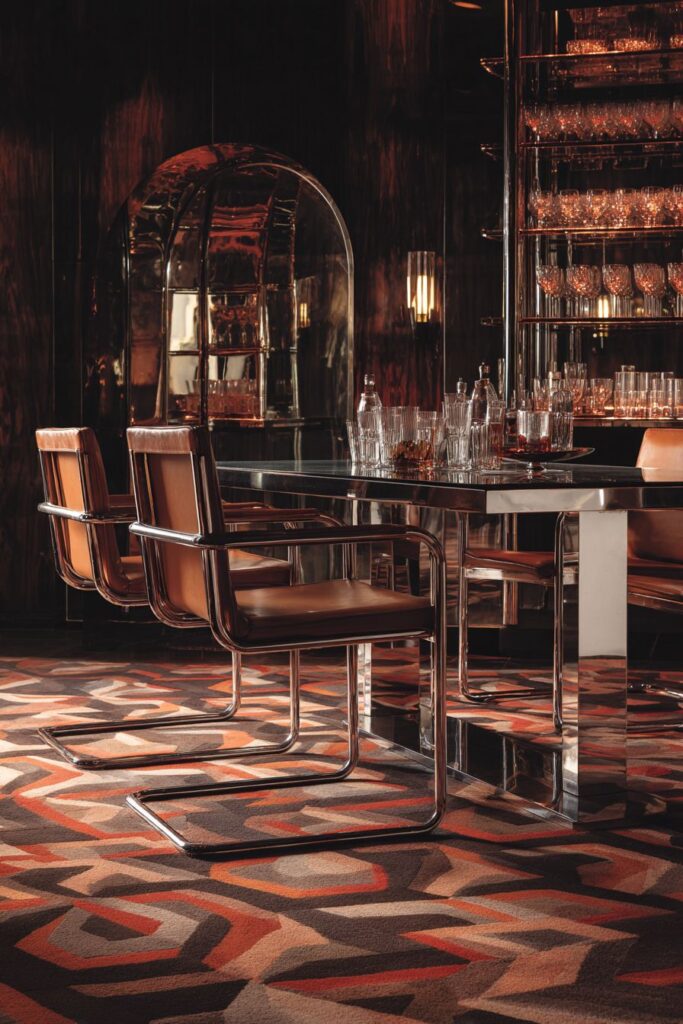
Cantilever chairs upholstered in rich cognac leather provide both comfort and visual warmth, their floating appearance creating a sense of weightlessness that complements the glass table’s transparency. The cognac leather ages beautifully, developing a rich patina that adds character over time while maintaining its luxurious appeal. These chairs represent the era’s innovative structural engineering, with their cantilever design eliminating rear legs for a cleaner, more modern silhouette.
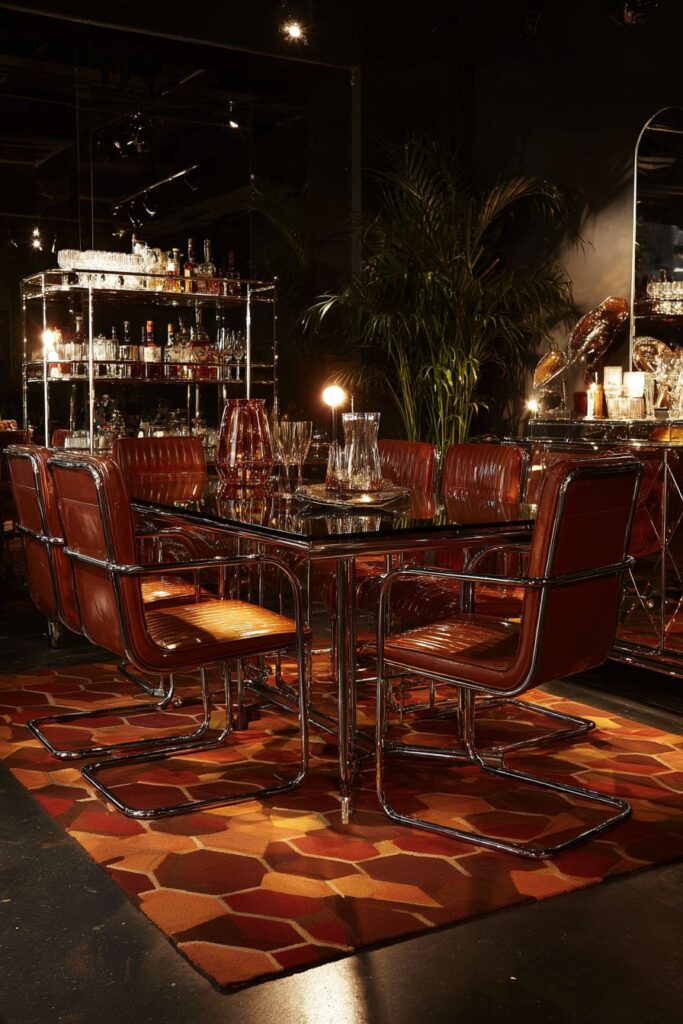
The bold geometric area rug in orange and brown tones beneath the dining set serves multiple purposes beyond mere floor covering. It defines the dining area within a larger space, provides acoustic benefits, and introduces pattern and color that warm up the cool materials of the furniture. The geometric patterns echo the atomic age’s fascination with mathematical precision and scientific discovery, while the warm color palette prevents the space from feeling cold or sterile.
A vintage bar cart with mirrored shelves embodies the period’s enthusiasm for entertaining and cocktail culture. This mobile piece allows for flexible service while adding glamour through its reflective surfaces. The mirrored shelves multiply the visual impact of the glassware they hold, creating sparkling displays that catch and reflect light throughout the room. The warm incandescent lighting creates subtle reflections on all these chrome surfaces, adding depth and richness to the sophisticated palette.
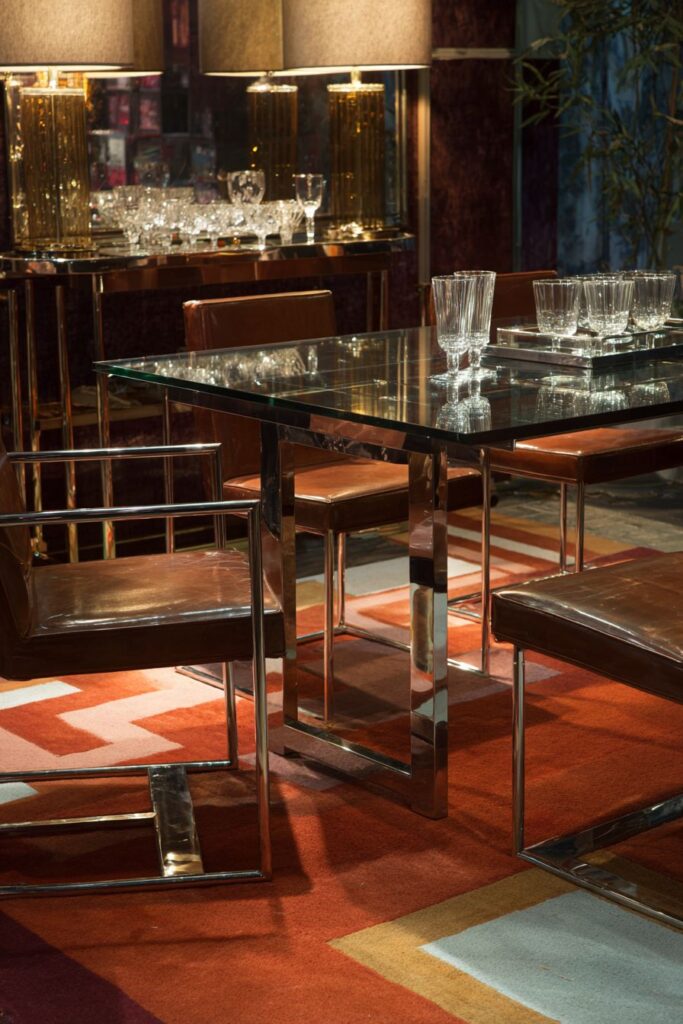
Key Design Tips:
- Use chrome and glass furniture to create sophisticated reflective surfaces
- Choose cantilever chairs for their innovative structural design and space-saving benefits
- Add geometric area rugs to define spaces and introduce warmth to cool materials
- Incorporate mirrored bar carts for both function and glamorous light reflection
- Install warm incandescent lighting to enhance chrome and glass surfaces
5. Live-Edge Walnut with Colorful Fiberglass Charm

The natural beauty of live-edge walnut takes center stage in this retro dining room, where an organic table edge celebrates the tree’s original form while steel hairpin legs provide industrial contrast. This combination perfectly captures the mid-century modern philosophy of honoring natural materials while embracing new manufacturing techniques. The live edge adds unique character that ensures no two tables are exactly alike, making each piece a distinctive work of functional art.

Surrounding this natural masterpiece, molded fiberglass shell chairs in cheerful yellow and white demonstrate the period’s revolutionary use of new materials. These chairs, born from wartime innovations in fiberglass production, represent democratized design—bringing sophisticated styling to the masses through affordable manufacturing processes. The bright colors inject optimism and energy into the space while the shell form provides ergonomic comfort that was revolutionary for its time.
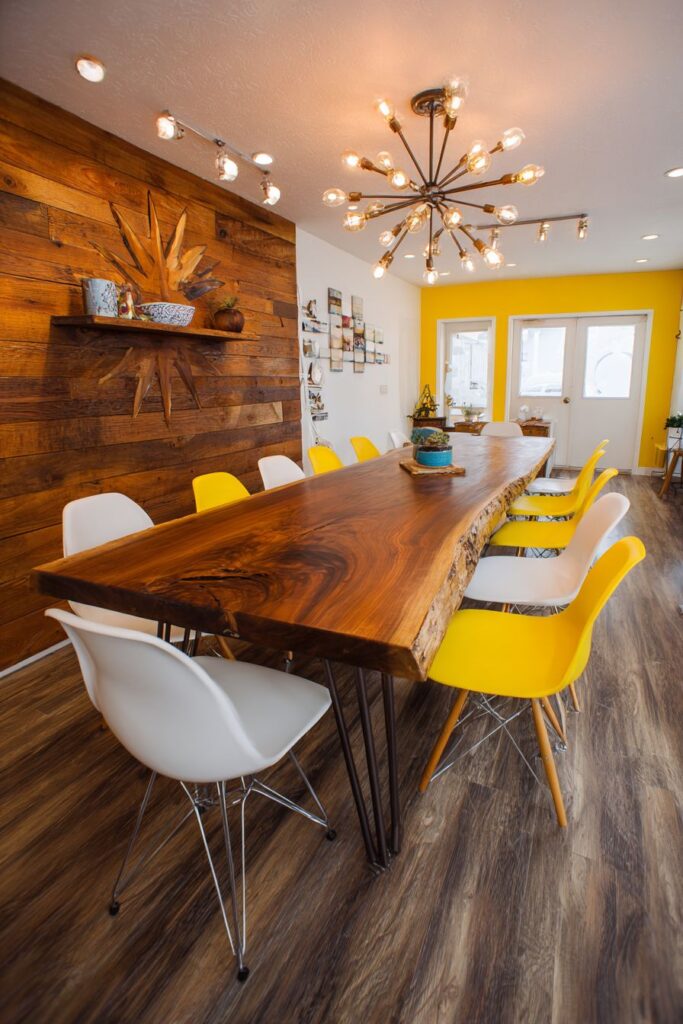
The striking sunburst wood accent wall creates a dramatic backdrop that emphasizes the room’s connection to natural materials while adding architectural interest. This feature wall technique, popular during the mid-century period, uses wood planks arranged in radiating patterns that echo atomic age motifs. The sunburst pattern draws the eye and creates a sense of movement and energy that complements the room’s dynamic furniture selection.
Floating shelves displaying vintage ceramics provide both storage and opportunities for curated displays that reflect the homeowner’s personality. These wall-mounted shelves maintain the period’s preference for clean lines and minimal visual weight while offering practical storage for dinnerware and decorative objects. The multi-armed chandelier with exposed Edison bulbs provides warm ambient lighting that highlights the wood grain and creates intimate dining atmosphere.

Key Design Tips:
- Embrace live-edge wood furniture for unique natural character and organic appeal
- Mix traditional materials like walnut with industrial elements like steel hairpin legs
- Choose molded fiberglass chairs in bright colors for authentic mid-century style
- Create dramatic accent walls using wood planks in geometric sunburst patterns
- Use exposed Edison bulb fixtures for warm, atmospheric lighting
6. Compact Round Design with Atomic Print Drama
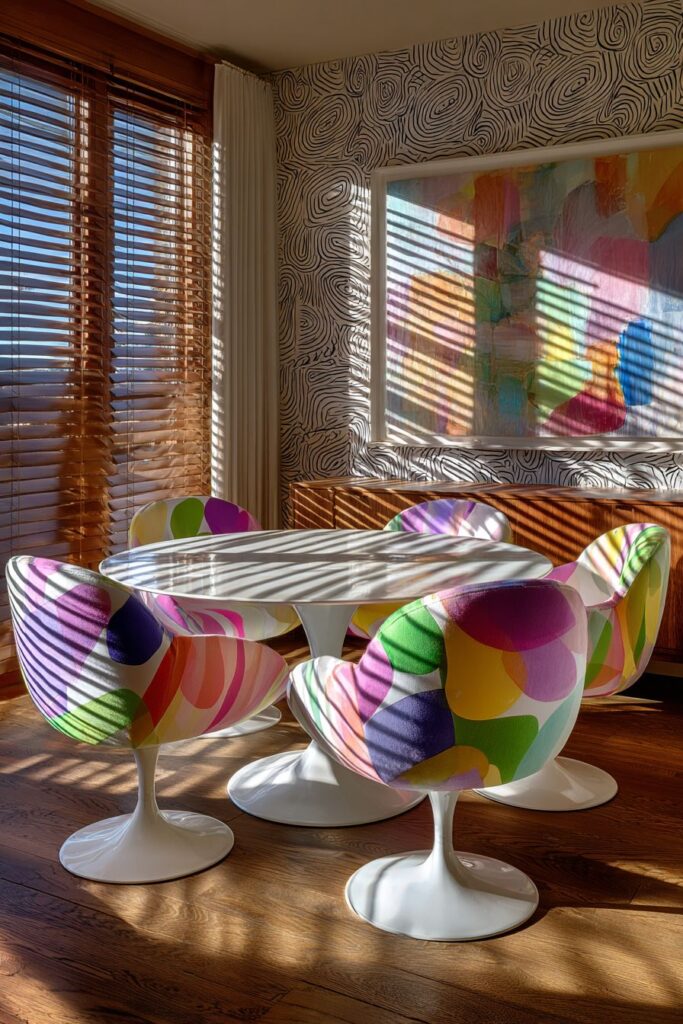
This compact retro dining room maximizes space through intelligent design choices, beginning with a round pedestal table in white laminate topped with wood grain that provides dining functionality without overwhelming the area. The pedestal base eliminates the need for four legs, creating more legroom and visual openness essential in smaller spaces. The combination of white laminate and wood grain reflects the period’s mastery of mixed materials and manufacturing innovations.
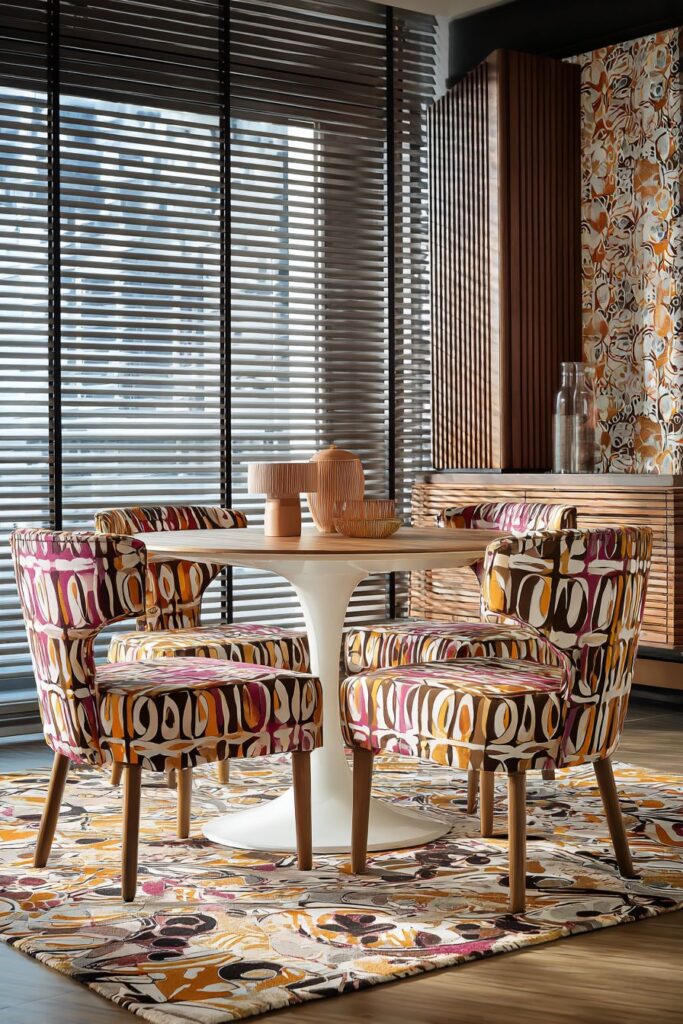
Four swivel chairs upholstered in vibrant geometric fabric surround the table, their compact size perfect for smaller dining areas while their swivel mechanism adds functionality and authentic mid-century appeal. The geometric fabric patterns capture the atomic age’s fascination with molecular structures and scientific discovery, transforming everyday seating into statement pieces that enliven the entire room. These fabrics often featured bold colors and abstract patterns that reflected the era’s optimistic view of the future.
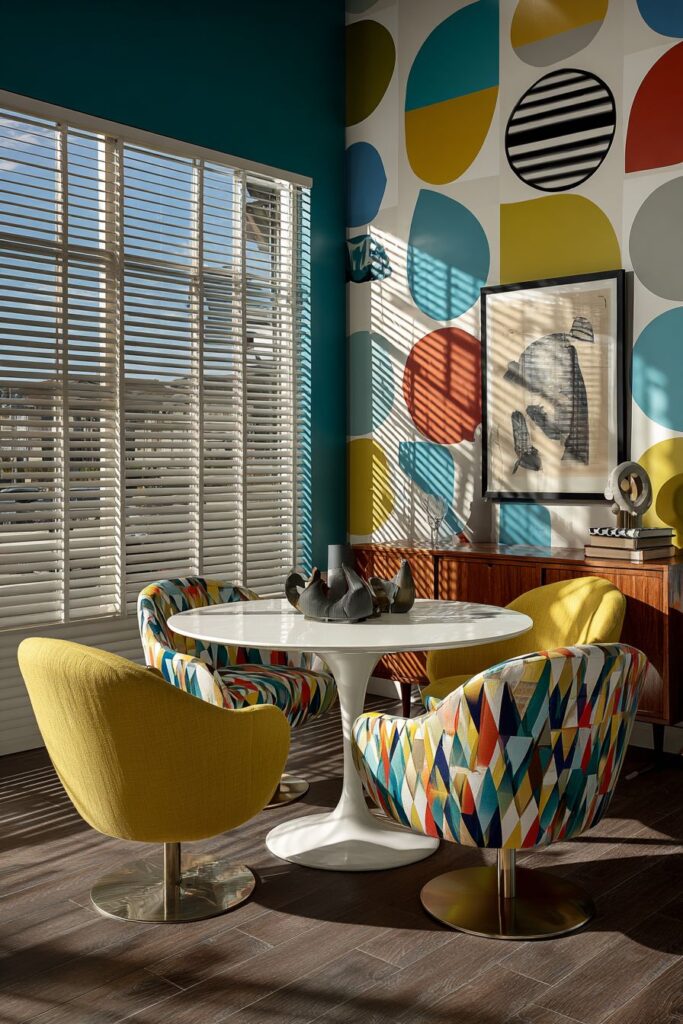
The classic atomic-print wallpaper feature wall serves as the room’s primary design statement, featuring interconnected circles, starbursts, or molecular patterns that were hallmarks of the period. This wallpaper transforms a simple dining area into a sophisticated space that captures the essence of atomic age design philosophy. The patterns create visual movement and interest without overwhelming the compact space.
A vintage sideboard in teak with sliding doors provides essential storage while maintaining the room’s clean aesthetic. The sliding doors, rather than hinged ones, save space while showcasing the period’s innovative approach to furniture functionality. Natural light filtering through horizontal blinds creates linear shadows that add depth and visual interest while maintaining privacy and light control.
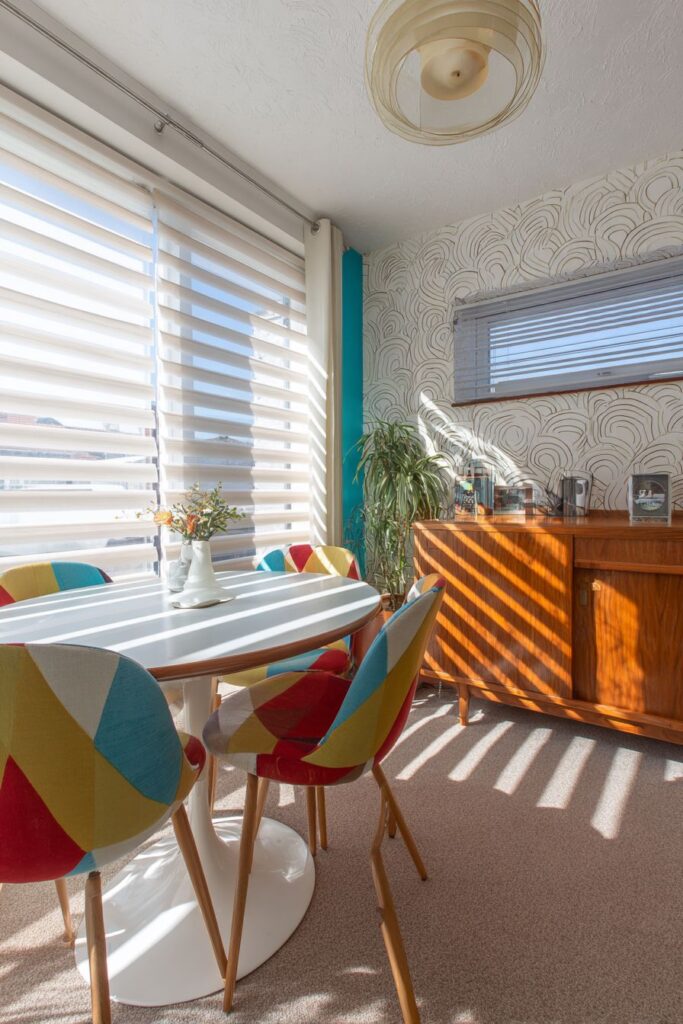
Key Design Tips:
- Choose round pedestal tables to maximize space and improve traffic flow
- Use swivel chairs for added functionality in compact dining areas
- Create feature walls with authentic atomic-print wallpaper for dramatic impact
- Select furniture with sliding doors to save space in smaller rooms
- Install horizontal blinds to control light while adding linear visual elements
7. Rosewood Luxury with Tufted Sophistication

The epitome of retro dining luxury emerges through this sophisticated space featuring a long rectangular dining table in rich rosewood with sleek chrome legs that exemplify the period’s mastery of mixed materials. Rosewood, prized for its deep color variations and striking grain patterns, represents the premium end of mid-century furniture design. The chrome legs provide structural support while their reflective finish adds visual lightness that prevents the substantial table from dominating the room.
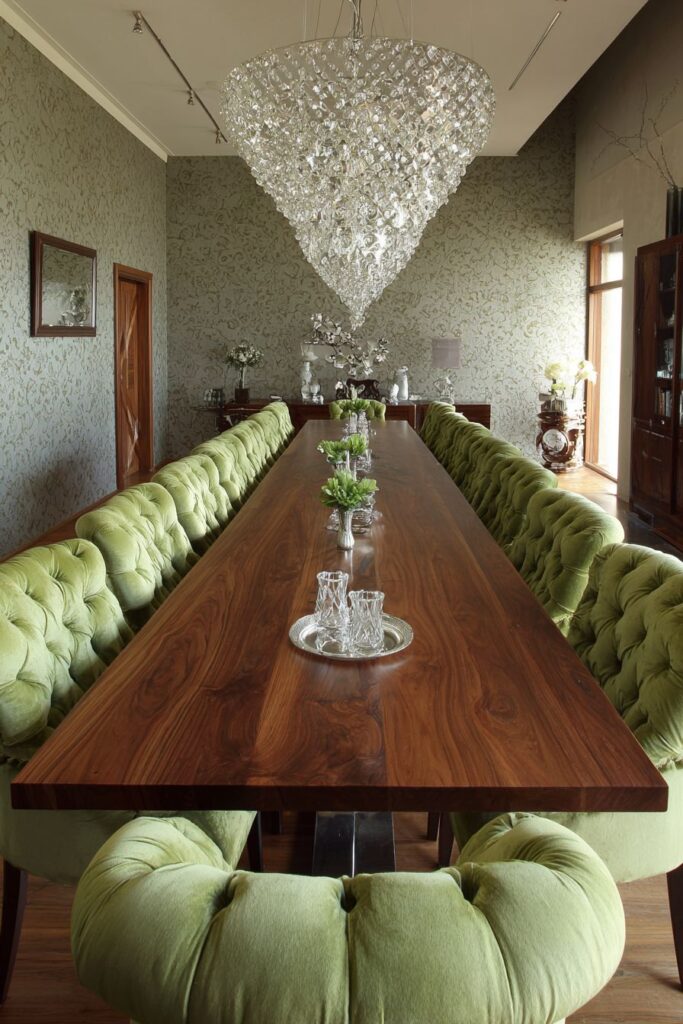
High-back dining chairs with tufted vinyl upholstery in sophisticated avocado green demonstrate the period’s innovative approach to seating design and materials. The tufting technique, borrowed from traditional upholstery methods, adds texture and visual interest while the vinyl material represents mid-century embrace of synthetic materials for their durability and easy maintenance. The avocado green color, iconic to the era, adds richness without overwhelming the space’s sophisticated palette.

Textured grasscloth wallpaper provides a natural backdrop that adds subtle texture and visual warmth without competing with the furniture’s dramatic presence. This wallpaper choice reflects the period’s appreciation for natural materials and textures, creating depth and interest through its woven appearance. The neutral tones of grasscloth allow the furniture’s rich colors and finishes to take center stage while adding sophisticated texture.
A vintage crystal chandelier with geometric details provides elegant illumination while honoring the period’s love of geometric forms and quality materials. The crystal elements catch and reflect light throughout the room, creating sparkle and visual interest that elevates the dining experience. A matching credenza displays period-appropriate serving pieces and decorative objects, creating curated vignettes that enhance the room’s sophisticated atmosphere.
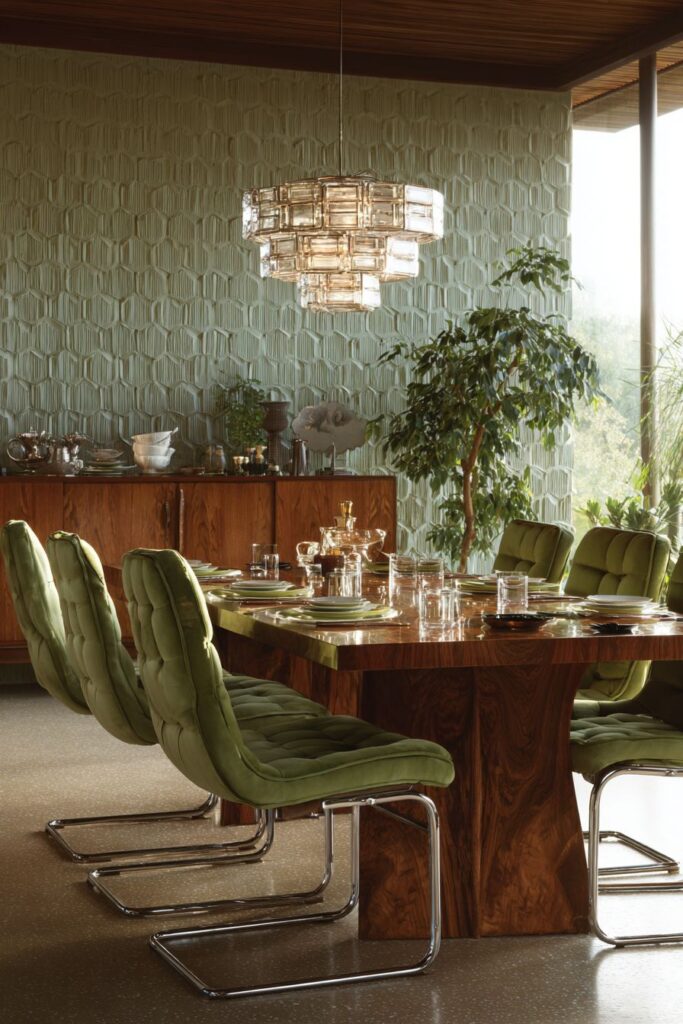
Key Design Tips:
- Invest in premium wood species like rosewood for dramatic grain patterns and rich color
- Use tufted upholstery to add texture and traditional luxury to modern forms
- Choose grasscloth wallpaper for subtle texture without pattern competition
- Select crystal chandeliers with geometric details for elegant period-appropriate lighting
- Display curated collections of serving pieces and decorative objects for sophisticated styling
8. Vibrant Tulip Table with Bold Floral Expression
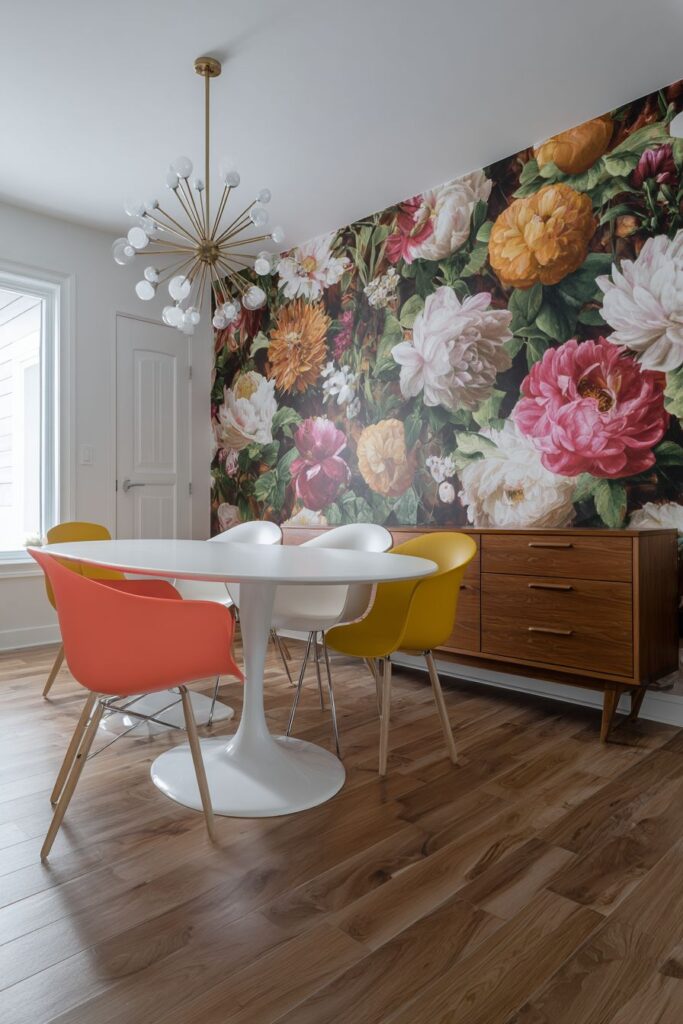
The iconic tulip table design reaches its full potential in this vibrant retro dining room, where the sleek oval dining table features the classic white tulip base paired with a rich walnut top. This combination showcases the genius of mid-century design—the sculptural base eliminates visual clutter while the warm wood top adds natural beauty and durability. The oval shape promotes conversation and creates a more intimate dining experience than rectangular alternatives.
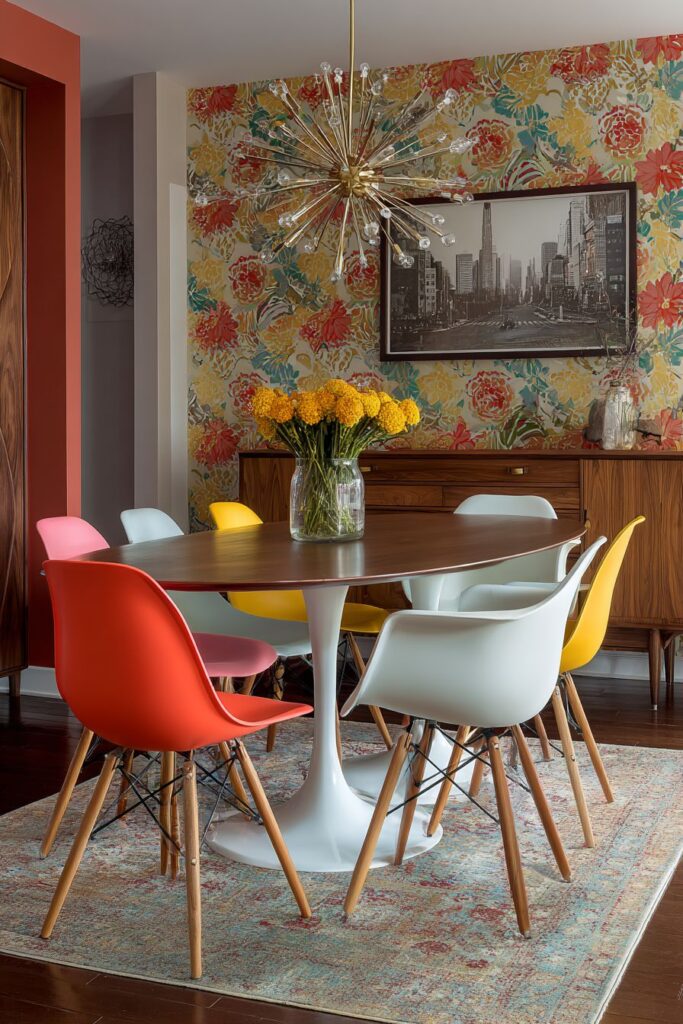
Colorful molded plastic chairs in coral, yellow, and white surround the table, demonstrating the period’s revolutionary approach to seating design and manufacturing. These chairs represent the democratization of good design, bringing sophisticated styling within reach of average families through innovative production methods. The bright colors inject joy and optimism into the space while their molded forms provide surprising comfort and ergonomic support.
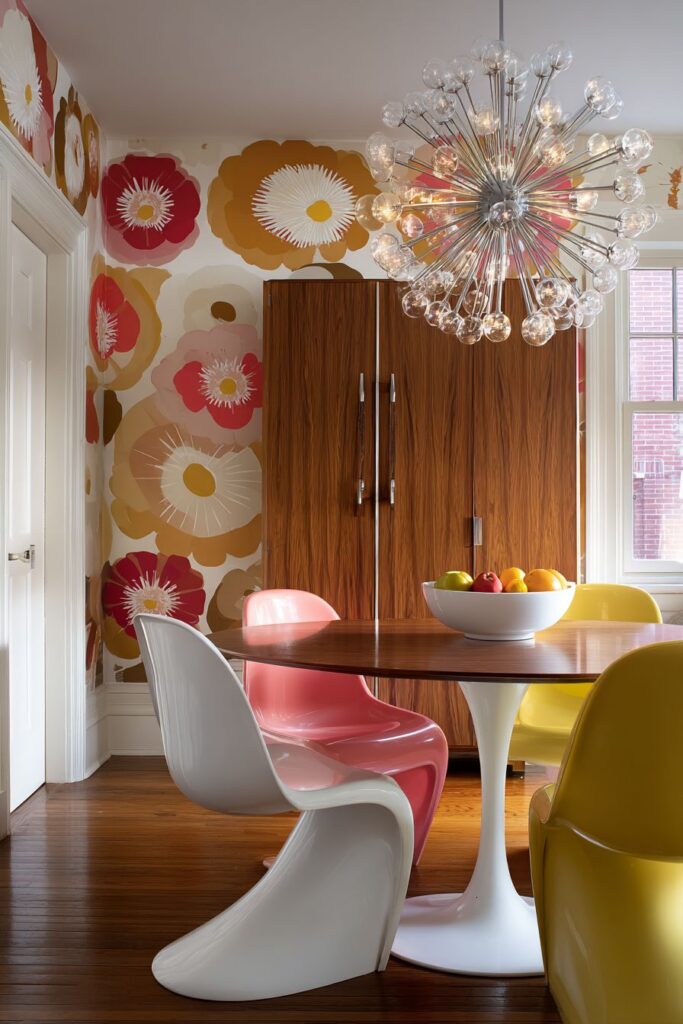
Bold floral wallpaper in warm tones creates a dramatic backdrop that balances the geometric precision of the furniture with organic, natural forms. This wallpaper choice reflects the period’s complex relationship with nature—while embracing industrial materials and processes, designers still sought connection to natural forms through pattern and motif. The large-scale floral patterns create visual impact while warm tones maintain the room’s welcoming atmosphere.
A vintage teak buffet with distinctive hardware provides storage and serving functionality while showcasing the period’s attention to detail in furniture design. The distinctive hardware, often featuring geometric forms or atomic-age motifs, transforms functional elements into decorative features. The classic Sputnik chandelier provides dramatic lighting that captures the space age optimism of the era while creating a stunning focal point above the dining table.
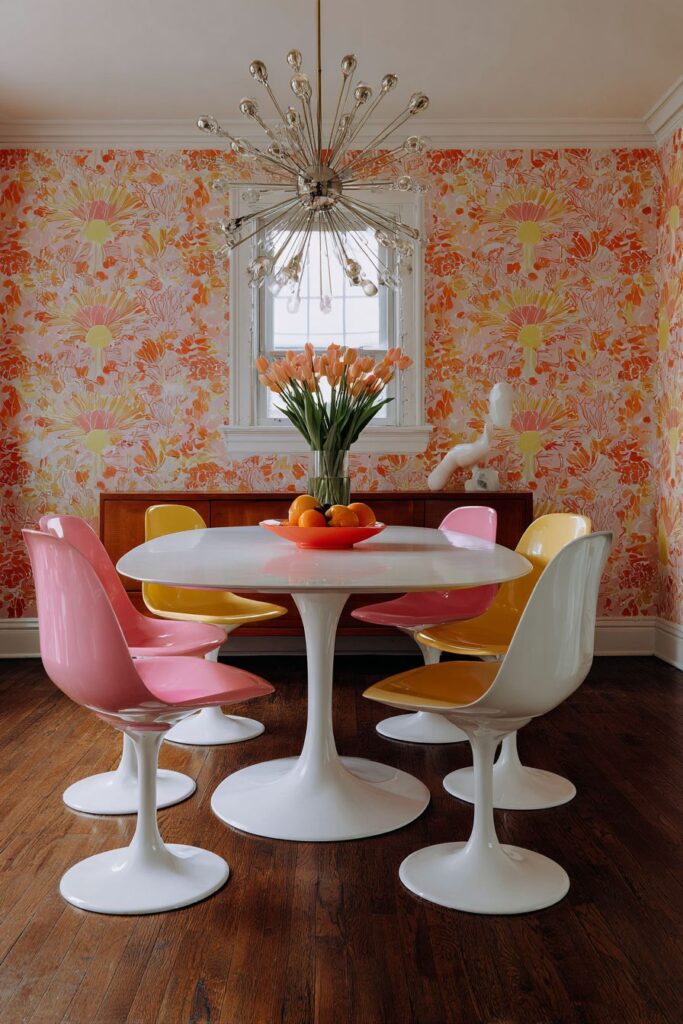
Key Design Tips:
- Choose tulip tables for their sculptural beauty and space-saving pedestal design
- Mix bright colored chairs for playful energy and authentic mid-century appeal
- Balance geometric furniture with organic floral patterns in wallpaper or textiles
- Select furniture with distinctive hardware that doubles as decorative elements
- Use Sputnik chandeliers for dramatic space-age lighting and focal point creation
9. Chrome X-Base Innovation with Textured Comfort
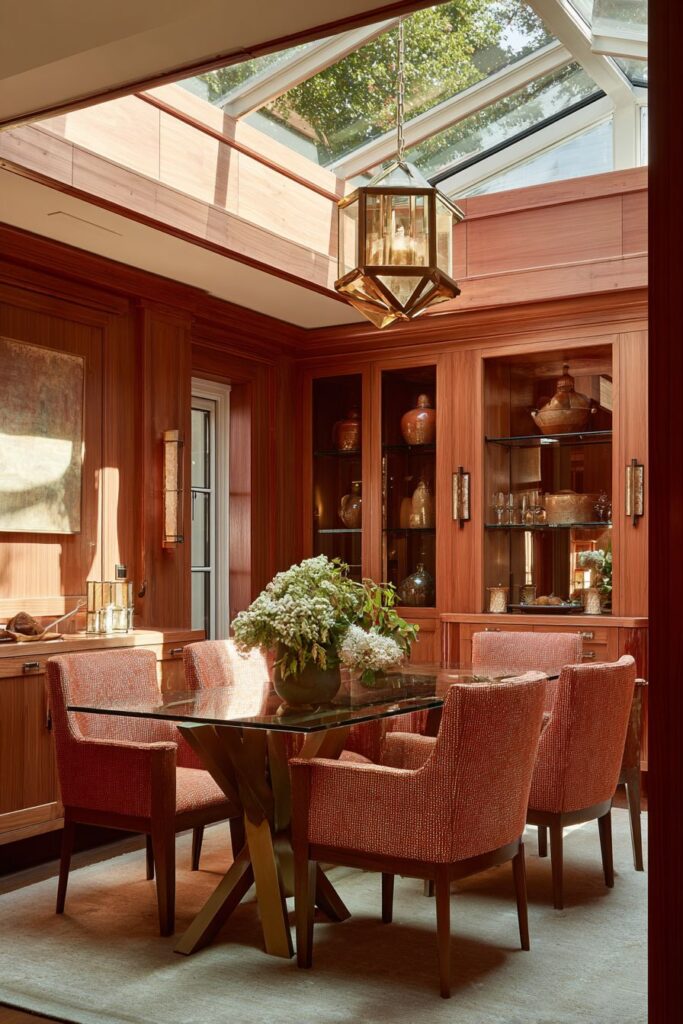
The structural innovation of mid-century design shines through this retro dining room’s square dining table featuring a distinctive chrome X-base that supports a thick glass top. This design demonstrates the period’s engineering prowess and aesthetic boldness—the X-base provides exceptional stability while its geometric form creates visual drama. The thick glass top adds substance while maintaining transparency that keeps the space feeling open and airy.
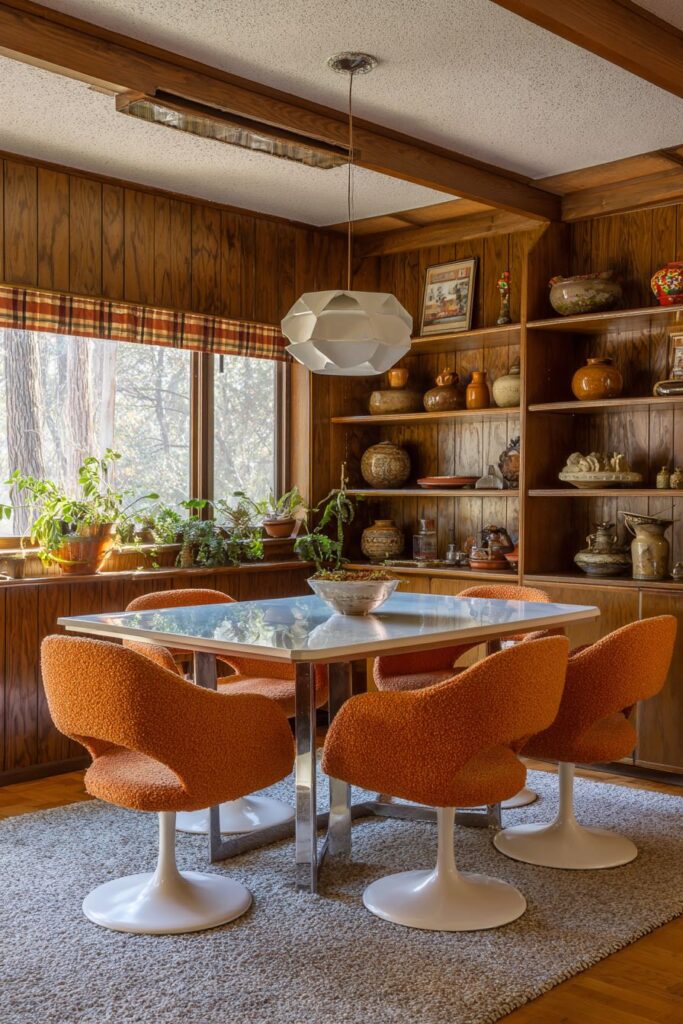
Bucket chairs upholstered in textured orange fabric surround the table, their curved forms providing ergonomic comfort while their bold color adds warmth to the cool chrome and glass materials. These chairs represent the period’s innovative approach to seating, with their bucket shape cradling the user while the textured fabric adds visual and tactile interest. The orange color, popular throughout the retro period, energizes the space and creates a cheerful dining atmosphere.
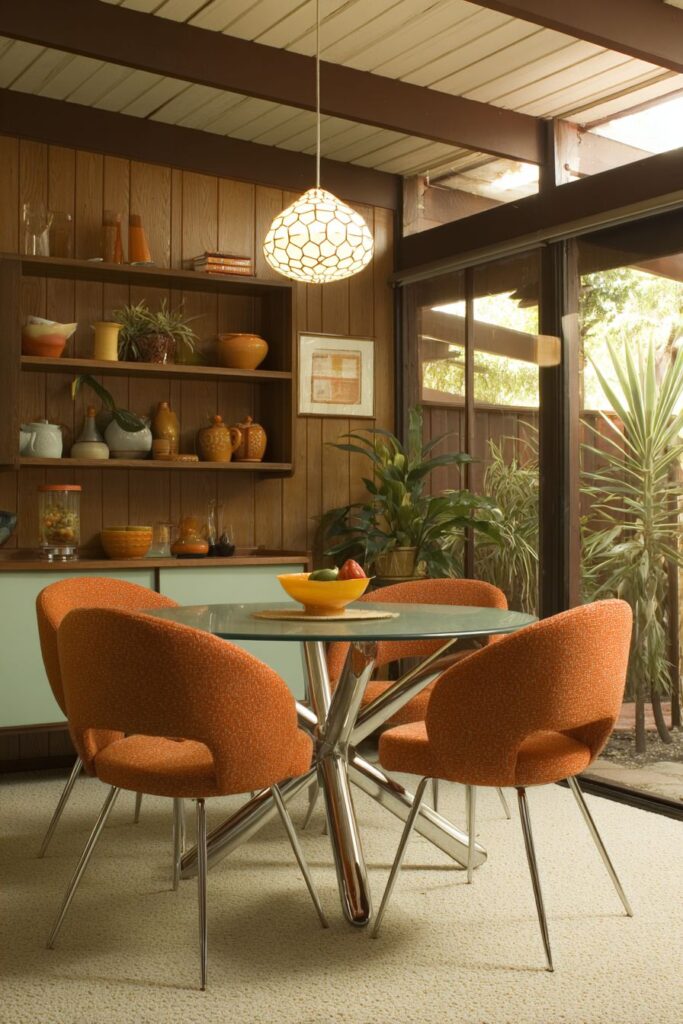
Wood-paneled walls with built-in display niches create architectural interest while providing practical storage and display opportunities. These niches, carefully proportioned and integrated into the wall system, hold vintage pottery and glassware that add personality and color to the room. The wood paneling adds warmth and natural texture that balances the industrial materials of the furniture while creating a cohesive design environment.
A geometric pendant light fixture hangs above the table, its angular form echoing the X-base design while providing focused task lighting for dining. This fixture represents the period’s fascination with geometric forms and space-age aesthetics. Natural daylight streaming through clerestory windows highlights the room’s authentic materials and creates interesting light patterns throughout the day.
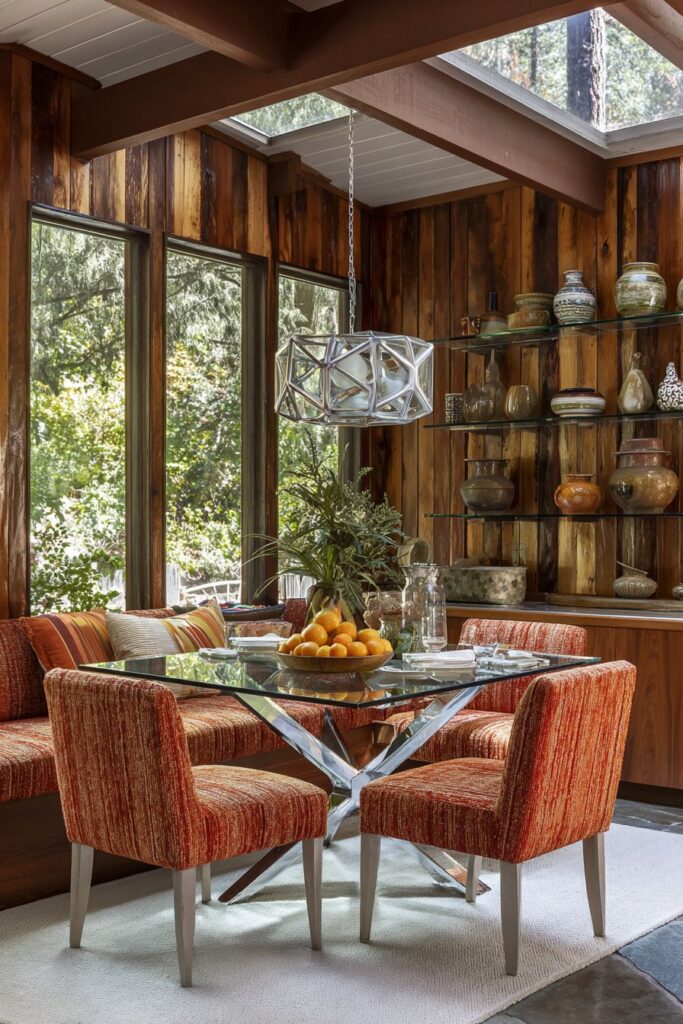
Key Design Tips:
- Choose furniture with innovative structural elements like X-base designs for visual drama
- Use textured fabrics in bold colors to add warmth to industrial materials
- Create built-in display niches for integrated storage and decorative opportunities
- Select geometric lighting fixtures that echo furniture forms for design cohesion
- Install clerestory windows for natural light without sacrificing privacy
10. Sculptural Boat-Shaped Elegance with Sophisticated Details
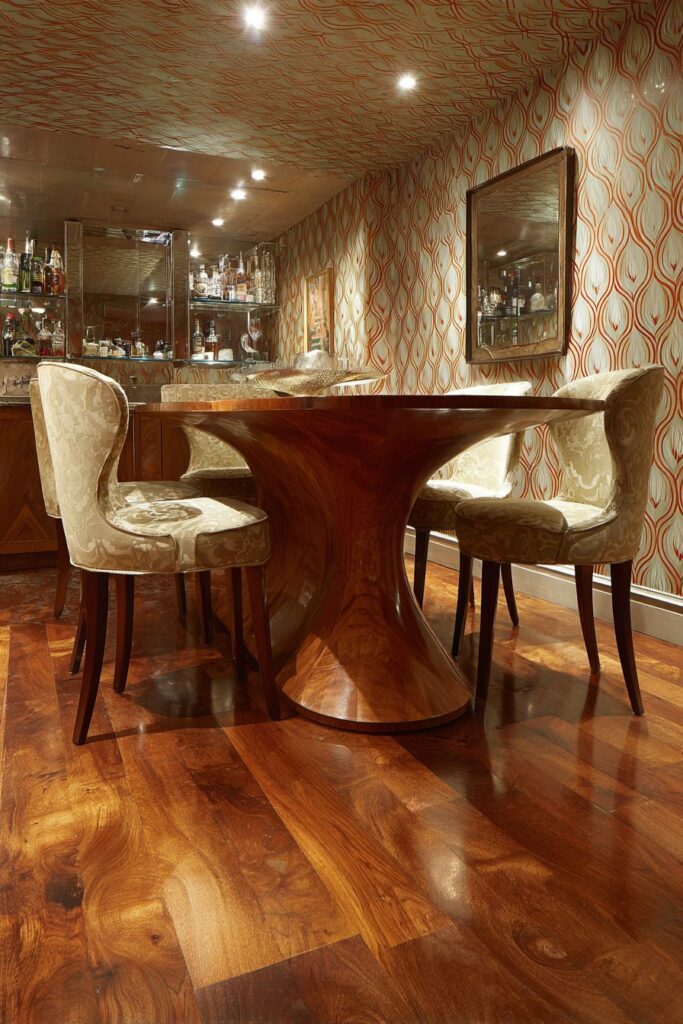
The sculptural beauty of mid-century furniture design reaches its pinnacle in this retro dining room featuring a distinctive boat-shaped dining table in rich teak with a sculptural pedestal base. This table represents the period’s most sophisticated furniture design, where function meets art in a piece that serves as the room’s primary focal point. The boat shape promotes conversation and creates visual movement, while the sculptural base eliminates the need for traditional legs.
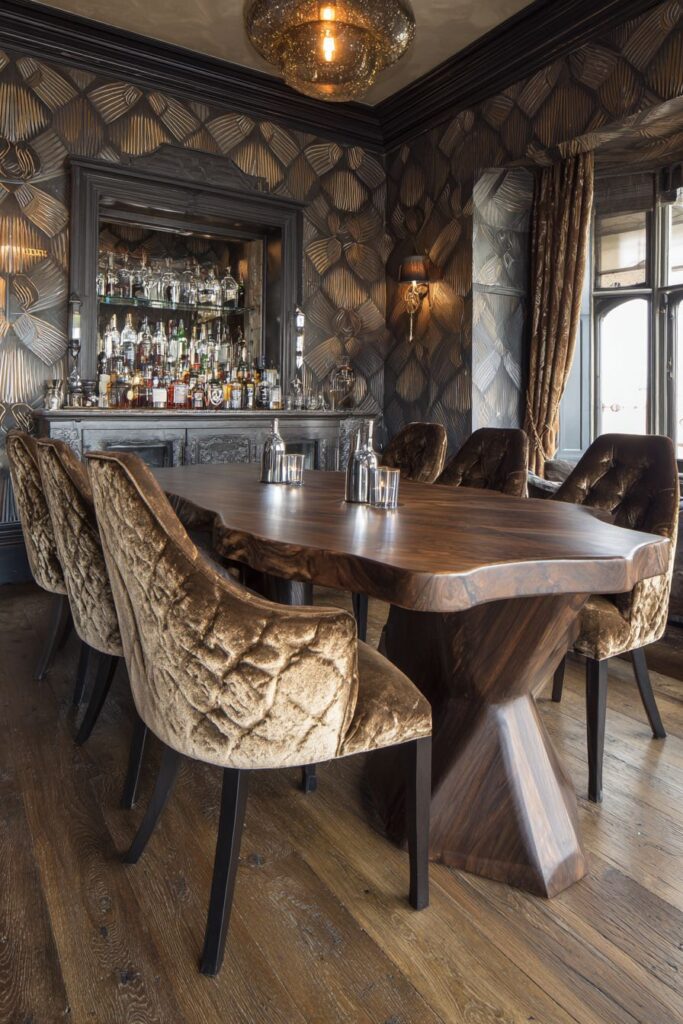
Six upholstered chairs featuring curved backs and tapered legs surround this masterpiece, their forms echoing the table’s organic curves while maintaining the period’s characteristic restraint. The curved backs provide ergonomic support while creating visual rhythm around the table, and the tapered legs add elegance and lightness. The upholstery provides comfort while allowing the chairs’ structural beauty to remain visible.
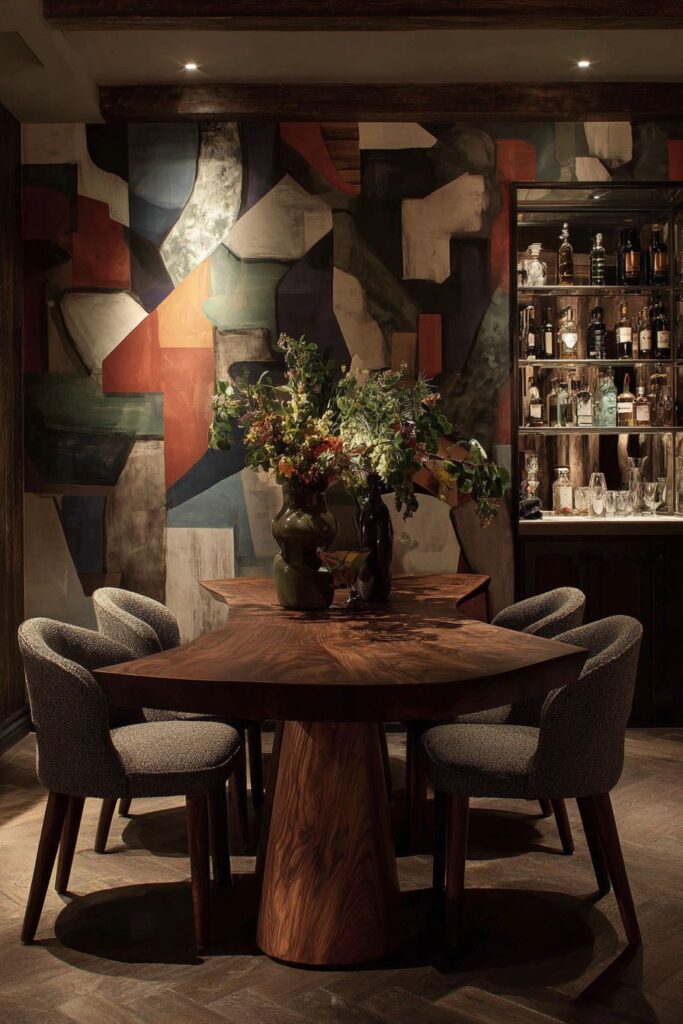
Striking geometric wallpaper in earth tones creates a sophisticated backdrop that complements rather than competes with the furniture’s dramatic forms. These patterns, often featuring interlocking shapes or atomic-age motifs, add visual interest while their earth tones maintain the room’s sophisticated palette. The geometric precision provides contrast to the furniture’s organic curves while remaining true to mid-century aesthetic principles.
A vintage bar setup with mirrored backing creates an entertainment center that reflects the period’s cocktail culture and social dining traditions. The mirrored backing amplifies light and creates the illusion of expanded space while displaying glassware and barware as decorative elements. Warm artificial lighting creates intimate ambiance while highlighting the rich wood grain and sophisticated material choices throughout the space.
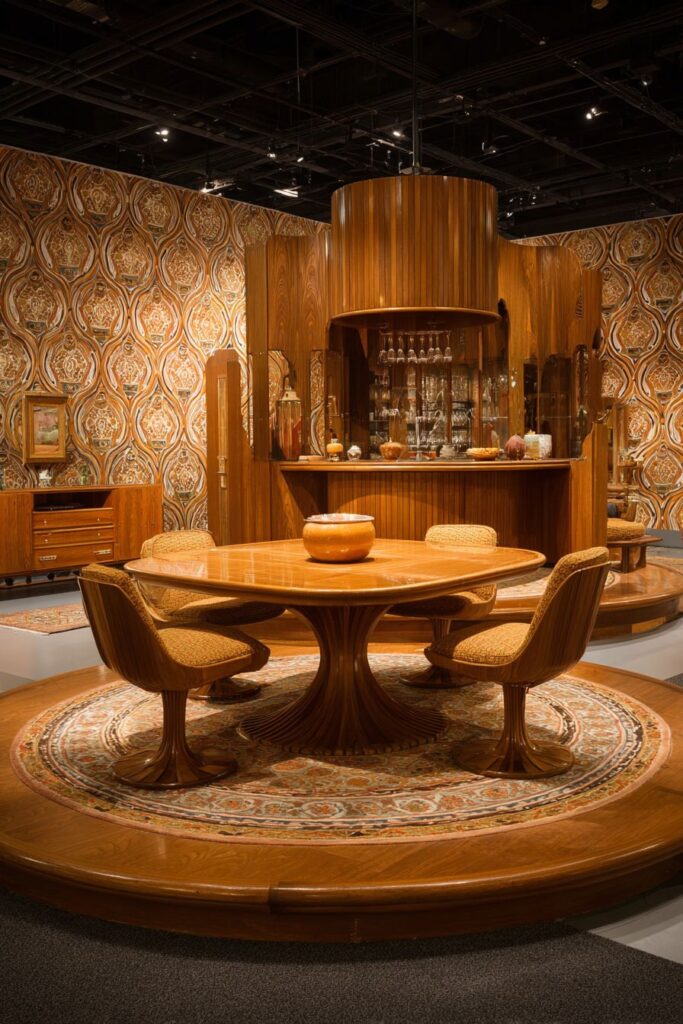
Key Design Tips:
- Invest in sculptural furniture pieces that serve as functional art
- Choose curved chair backs for ergonomic comfort and visual rhythm
- Use geometric wallpaper in earth tones for sophisticated pattern without overwhelming
- Create bar areas with mirrored backgrounds for glamour and space amplification
- Install warm artificial lighting for intimate dining atmosphere
11. Chrome Tube Frame Innovation with Cane Texture

The technological innovation of mid-century furniture design comes alive in this retro dining room featuring a rectangular glass dining table supported by a distinctive chrome tube frame that showcases the period’s mastery of metal bending and engineering. This table design represents the era’s fascination with industrial processes adapted for residential use, where the chrome tubing provides both structural support and aesthetic appeal. The glass top maintains visual lightness while the chrome frame creates geometric interest.

Cantilever chairs with woven cane seats and backs surround the table, demonstrating the period’s successful marriage of traditional materials with innovative structural design. The cantilever principle eliminates rear legs for a floating appearance that was revolutionary when introduced, while the woven cane provides natural texture and breathability. This combination of high-tech structure with natural materials epitomizes mid-century design philosophy.
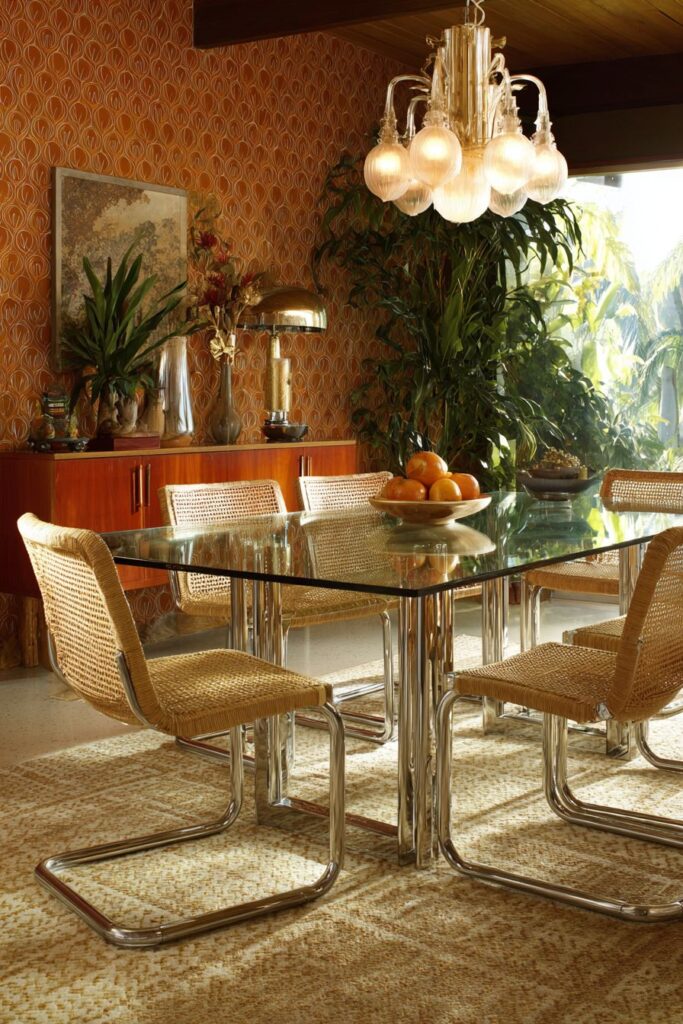
Bold graphic wallpaper in brown and orange tones creates a dramatic backdrop that captures the era’s love of geometric patterns and warm earth colors. These graphic patterns often featured interlocking shapes, atomic motifs, or mathematical precision that reflected the period’s optimism about science and technology. The brown and orange color scheme adds warmth while maintaining the sophisticated restraint characteristic of quality mid-century design.
A vintage credenza with sliding tambour doors provides storage while showcasing innovative closure mechanisms that were hallmarks of the period. The tambour doors, made of flexible wood slats, slide smoothly to reveal interior storage while maintaining the furniture’s clean lines when closed. A multi-tiered chandelier with frosted glass globes provides period-appropriate lighting that diffuses evenly throughout the space.

Key Design Tips:
- Choose furniture that showcases technological innovation like chrome tube frames
- Use cantilever chairs for their revolutionary floating appearance and space efficiency
- Incorporate natural materials like cane to balance industrial elements
- Select graphic wallpaper patterns that reflect atomic age optimism
- Install multi-tiered chandeliers for even light distribution and period authenticity
12. Circular Pedestal Charm with Button Tufting
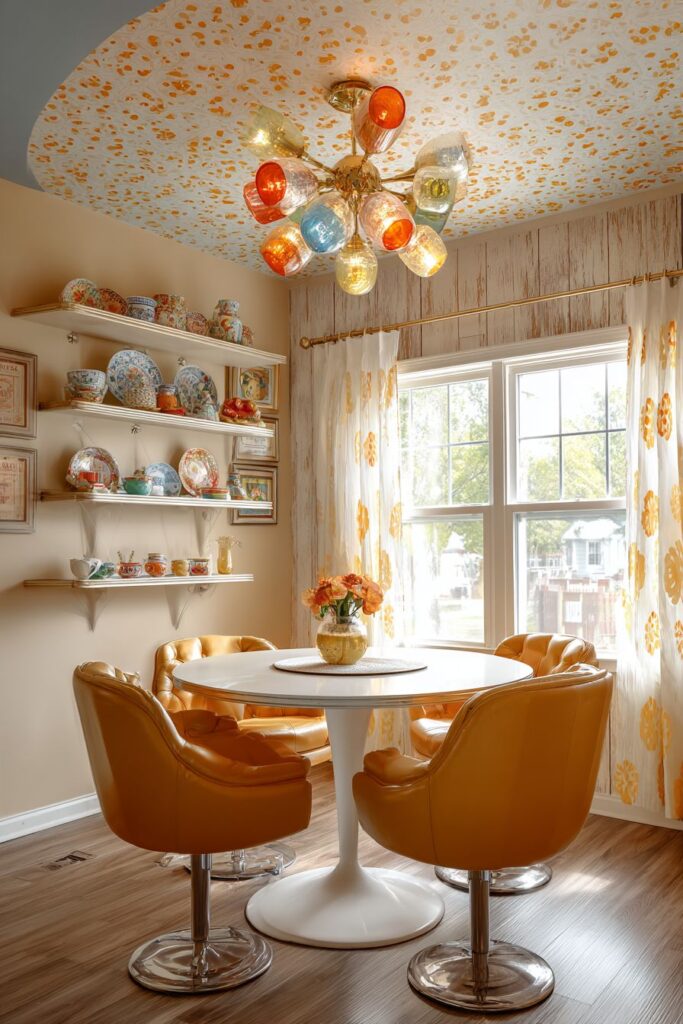
The timeless appeal of circular dining comes to life in this retro dining room centered around a pedestal dining table in gleaming white laminate and chrome that exemplifies the space-age aesthetics of the era. The circular form promotes equality and conversation among diners while the pedestal base maximizes legroom and creates visual lightness. The white laminate surface reflects the period’s embrace of new materials and easy maintenance, while the chrome base adds industrial sophistication.
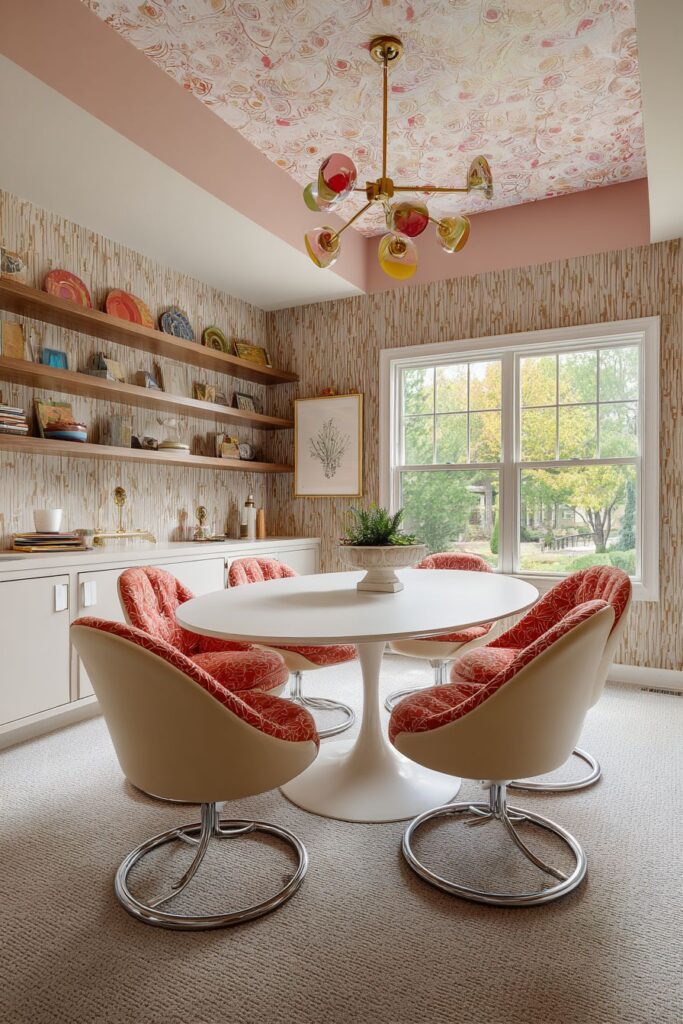
Swivel chairs upholstered in vinyl with distinctive button tufting in burnt orange surround the table, their swivel mechanism adding functionality while the tufting provides texture and visual interest. The button tufting technique, adapted from traditional upholstery methods, adds dimension and luxury to the synthetic vinyl material. The burnt orange color energizes the space and represents the bold color choices that defined mid-century interiors.
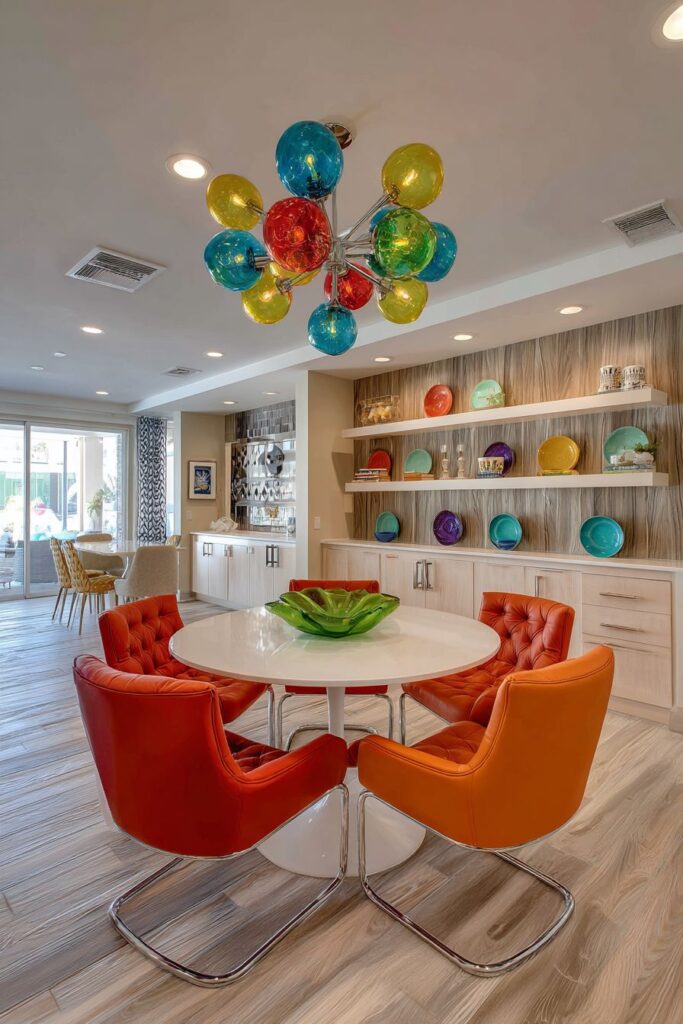
Wood-grain wallpaper creates visual warmth and natural texture without the expense of real wood paneling, demonstrating the period’s innovative use of printed materials to achieve desired aesthetics. This wallpaper choice reflects the era’s practical approach to design—achieving the look of expensive materials through technological innovation. Floating shelves displaying colorful vintage dishes create functional storage while showcasing the period’s colorful dinnerware and serving pieces.
A classic atomic-era ceiling fixture with multiple arms and colored glass shades completes the space with period-appropriate lighting that captures the optimism and technological fascination of the time. The multiple arms create dynamic shadows while the colored glass shades filter light to create warm, welcoming ambiance. This fixture type became iconic of the atomic age and space exploration era.
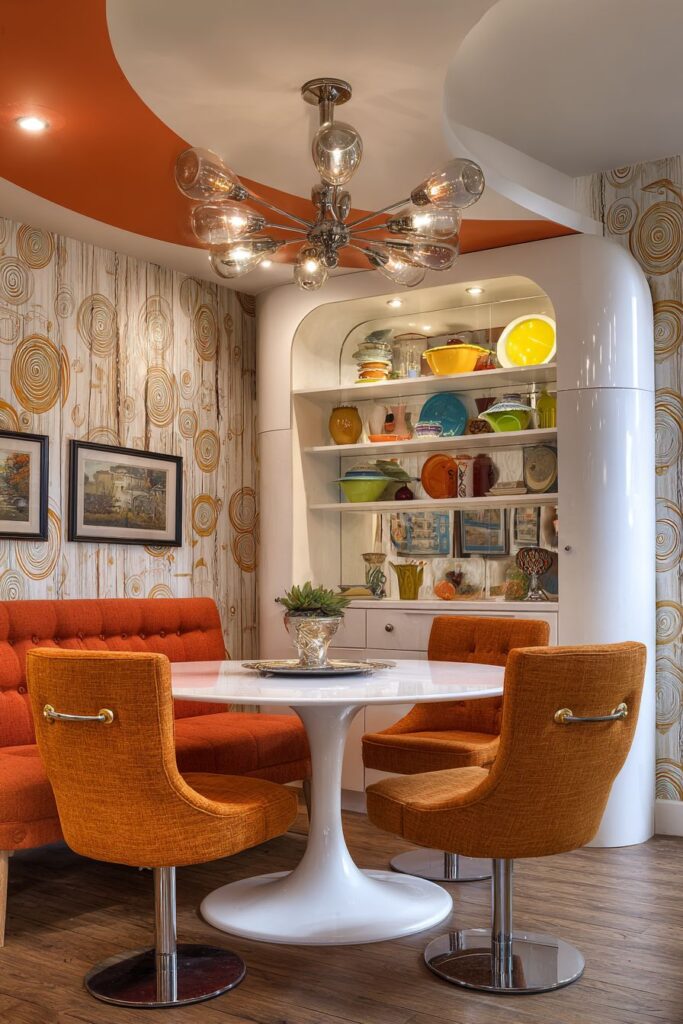
Key Design Tips:
- Use circular pedestal tables to promote conversation and maximize space efficiency
- Choose swivel chairs with button tufting for authentic mid-century functionality and style
- Apply wood-grain wallpaper for natural warmth without wood paneling expense
- Display colorful vintage dishes on floating shelves for functional decoration
- Select atomic-era fixtures with colored glass for authentic period lighting
13. Sculptural Teak Legs with Geometric Upholstery
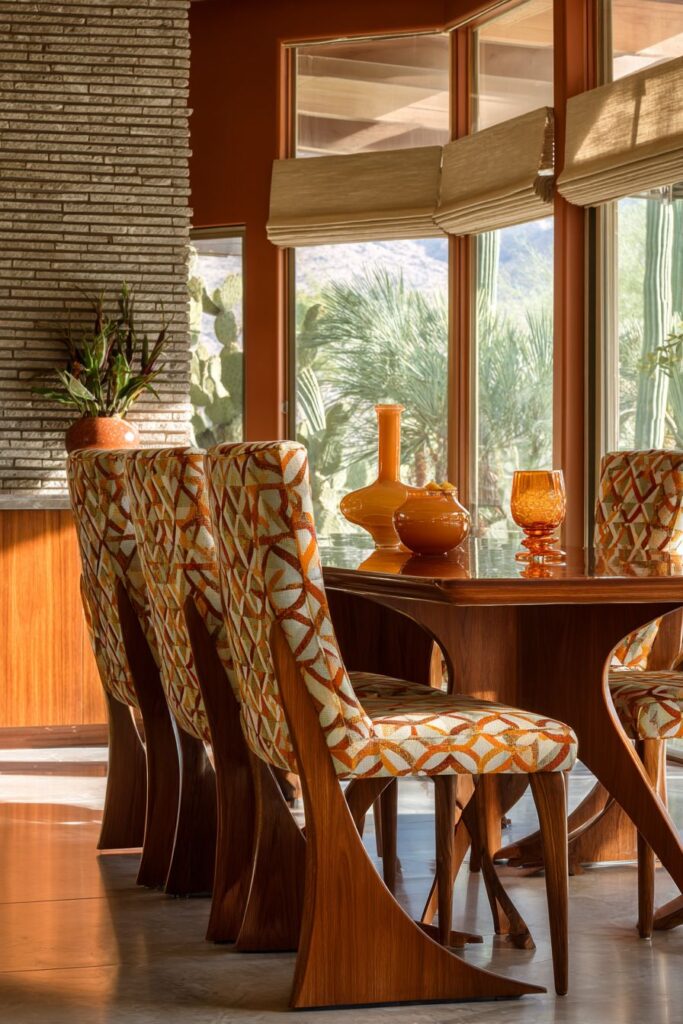
The artistry of mid-century furniture design reaches new heights in this retro dining room featuring a long teak dining table with distinctive sculptural legs that blur the line between furniture and fine art. These legs, crafted with curves and angles that create visual movement, demonstrate the period’s commitment to elevating everyday objects through exceptional design. The rich teak wood grain provides natural beauty while the sculptural elements add dramatic visual interest.

High-back dining chairs with geometric upholstery patterns in earth tones surround this masterpiece, their tall backs creating a sense of grandeur while providing excellent support for extended dining sessions. The geometric upholstery patterns reflect the atomic age’s fascination with mathematical precision and molecular structures, while the earth tones maintain sophistication and visual cohesion with the teak table.
A textured brick accent wall provides architectural interest and natural material contrast to the smooth wood furniture, adding warmth and tactile appeal that enhances the room’s sensory richness. The brick texture catches light and shadow throughout the day, creating ever-changing visual dynamics. A built-in corner cabinet displays vintage barware, integrating storage with the room’s architecture while showcasing period-appropriate accessories.
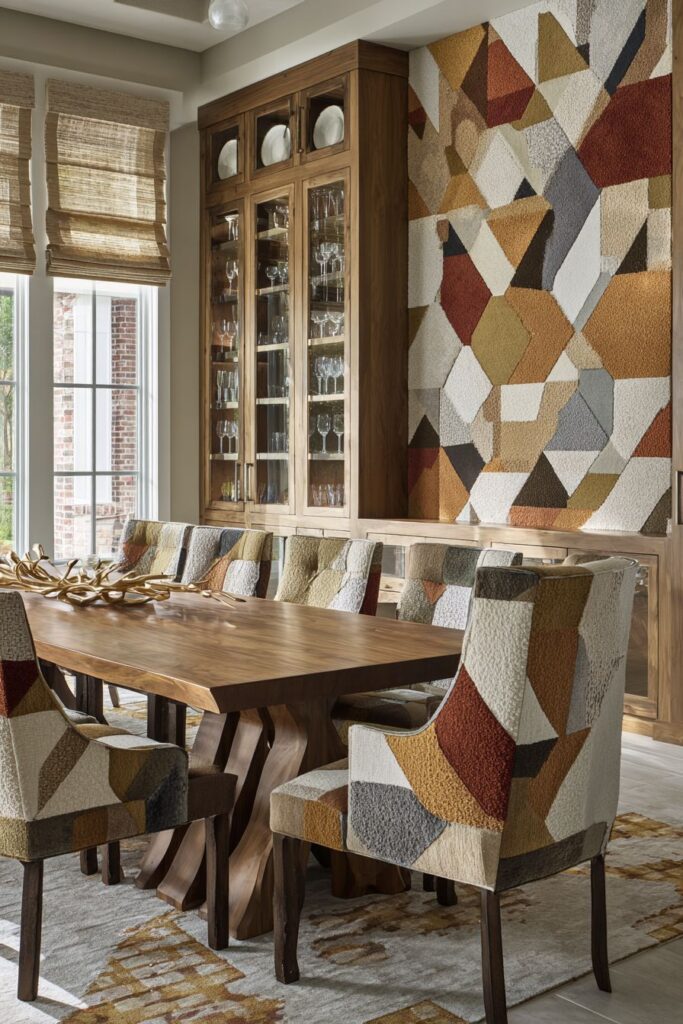
Natural light from large windows with simple Roman shades illuminates the space while maintaining privacy and light control. The Roman shades, with their clean horizontal lines when raised, complement the room’s geometric aesthetic while their soft fabric adds textural contrast to the hard surfaces. This natural lighting highlights the authentic materials and warm color palette that define the space.

Key Design Tips:
- Choose furniture with sculptural legs that serve as functional art pieces
- Use geometric upholstery patterns in earth tones for sophisticated pattern integration
- Add textured accent walls with brick or stone for material contrast
- Install built-in storage that integrates with the room’s architecture
- Select Roman shades for clean lines and effective light control
14. Hexagonal Innovation with Avocado Appeal
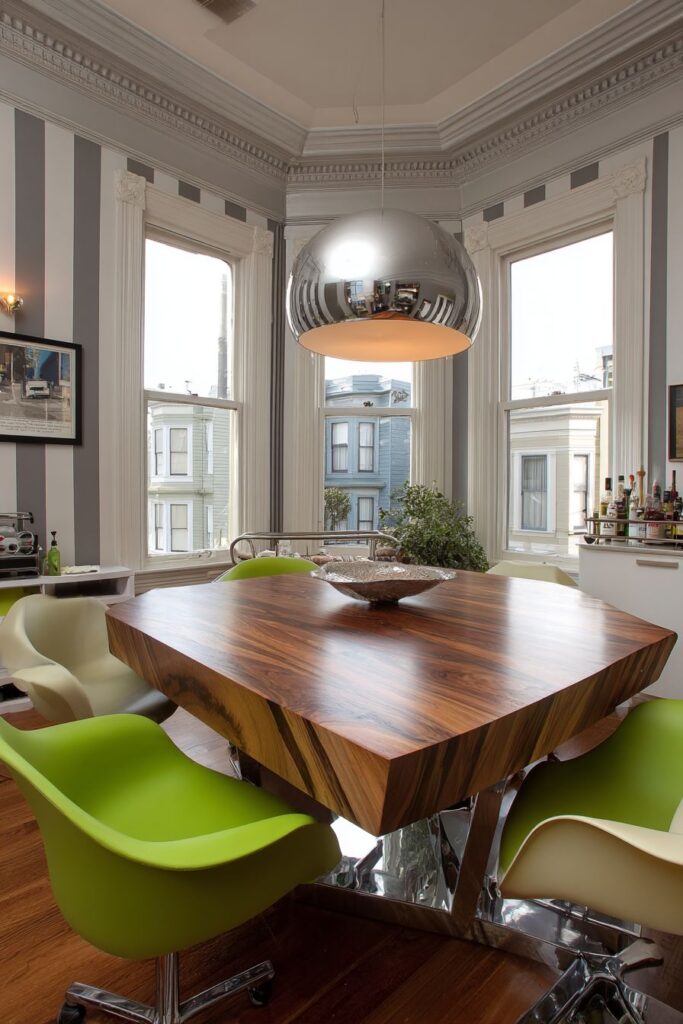
The geometric fascination of mid-century design finds perfect expression in this retro dining room’s unique hexagonal dining table featuring a thick walnut top supported by a geometric chrome base. This hexagonal form represents the period’s exploration of mathematical shapes beyond traditional rectangles and circles, creating visual interest while maintaining functional dining space. The thick walnut top provides substance and natural beauty, while the geometric chrome base adds structural drama and space-age appeal.
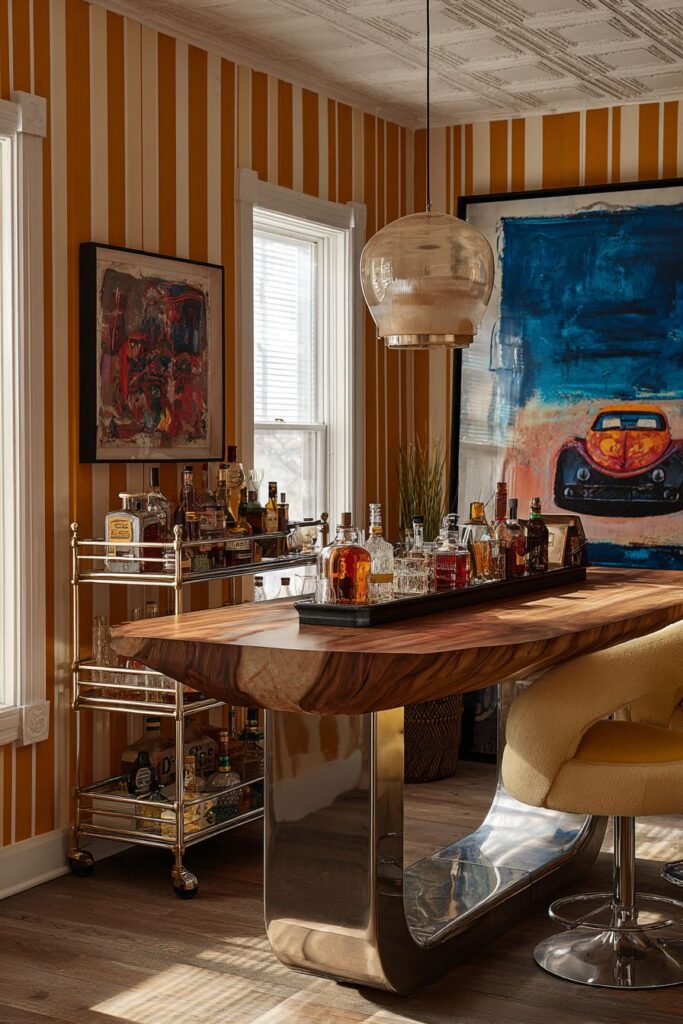
Molded fiberglass chairs in sophisticated avocado green and cream demonstrate the period’s mastery of color coordination and innovative materials. The avocado green, an iconic color of the era, adds richness and natural connection while the cream provides balance and brightness. These chairs showcase the democratization of good design through innovative manufacturing processes that made sophisticated styling accessible to broader audiences.
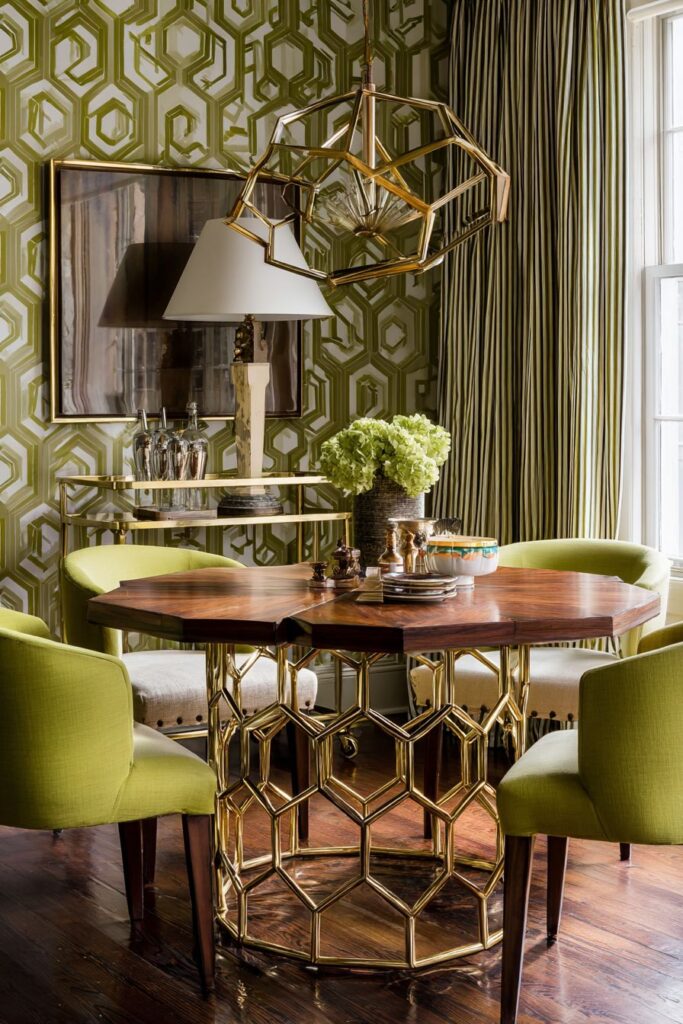
Bold striped wallpaper creates dynamic visual movement that complements the table’s geometric innovation while adding pattern and energy to the space. The stripes, whether vertical or horizontal, create optical effects that can alter perceived room proportions while adding contemporary flair. This wallpaper choice reflects the period’s bold approach to pattern and color in interior design.
A vintage rolling bar cart with brass accents provides mobile entertainment functionality while adding glamour through its metallic finish and mobility. The rolling mechanism allows for flexible service and space utilization, while the brass accents echo the warm metallic tones found throughout mid-century design. A statement pendant light with sculptural shade provides focused task lighting while serving as a three-dimensional art piece.
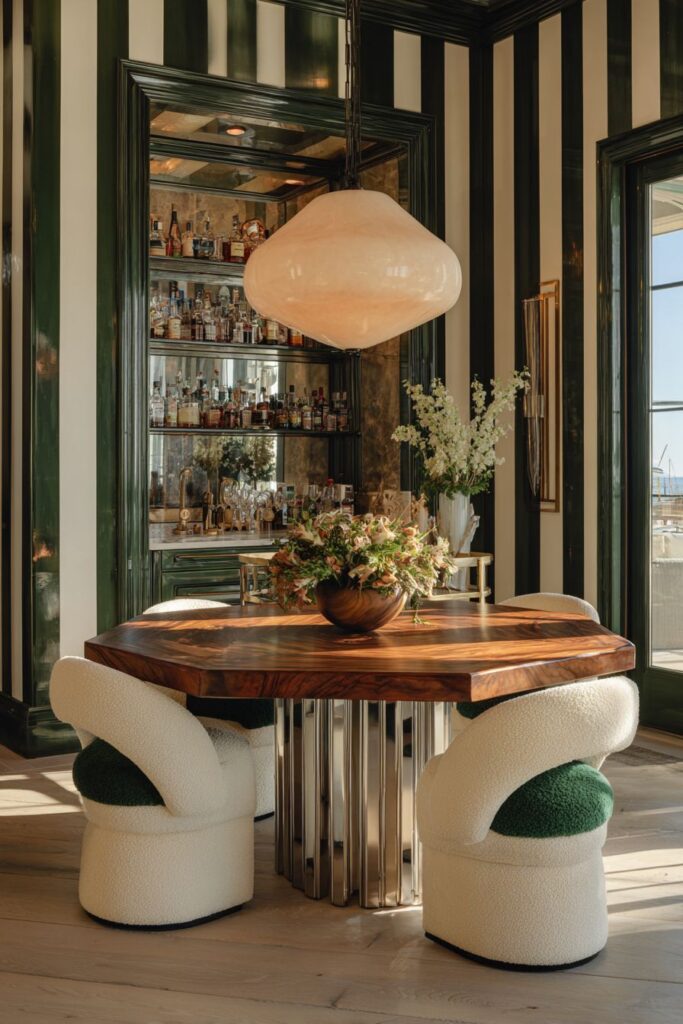
Key Design Tips:
- Explore geometric table shapes beyond traditional rectangles for unique visual impact
- Use iconic mid-century colors like avocado green for authentic period appeal
- Add bold striped wallpaper for dynamic visual movement and energy
- Include rolling bar carts for flexible entertainment and glamorous brass accents
- Choose sculptural pendant lights that function as hanging art pieces
15. Sophisticated Simplicity with Rush Seat Texture
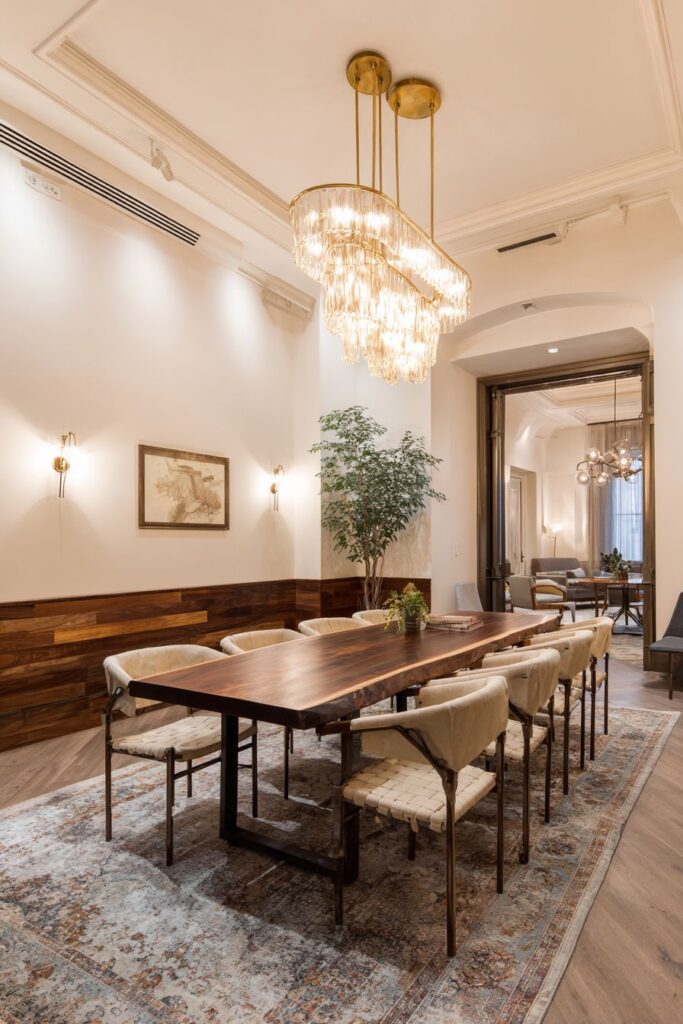
The refined simplicity that defines the best of mid-century design comes to life in this retro dining room featuring a sleek rectangular dining table in dark walnut supported by steel hairpin legs. This combination represents the period’s perfect balance of natural and industrial materials, where the rich walnut provides warmth and organic beauty while the hairpin legs add structural innovation and visual lightness. The dark walnut finish creates dramatic contrast and sophisticated appeal.
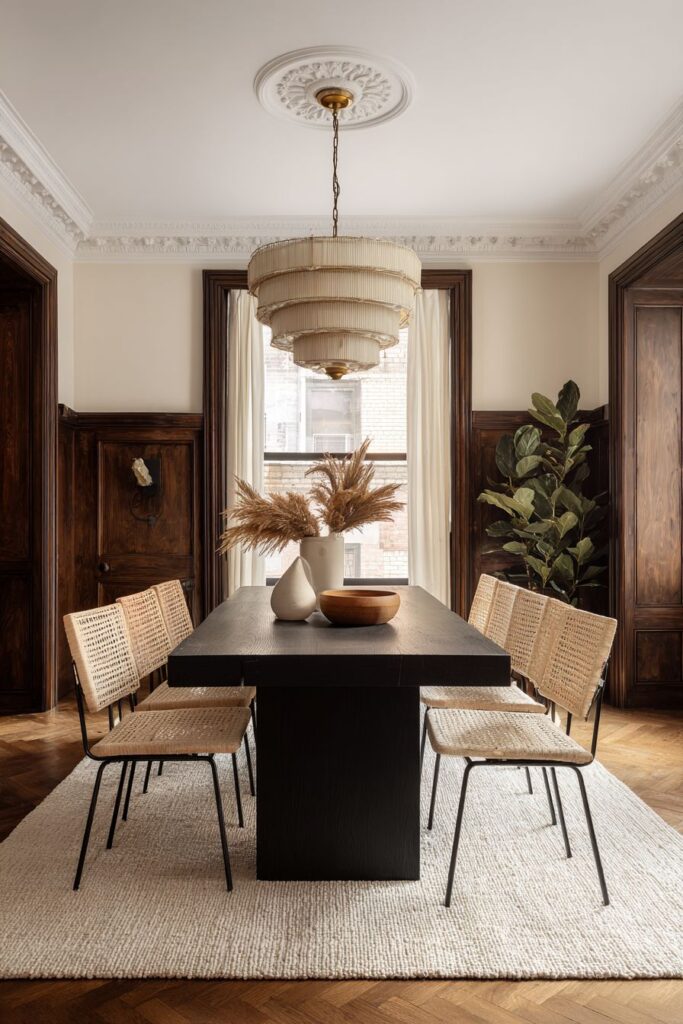
Ladder-back chairs with rush seats in natural finish surround the table, their traditional construction techniques updated with mid-century proportions and materials. The rush seats provide natural texture and breathability while honoring traditional craftsmanship methods that mid-century designers respected and incorporated into modern design. The ladder-back form creates vertical rhythm and visual interest while maintaining structural integrity.
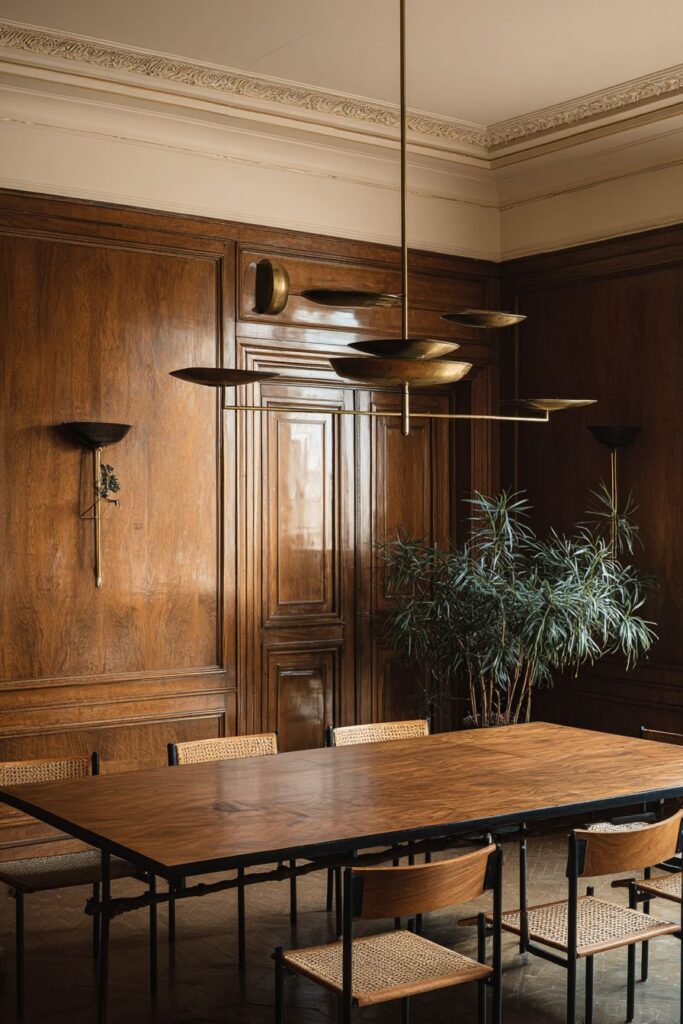
Wood paneling on the lower half of walls with painted upper sections in warm cream creates sophisticated two-tone treatment that adds architectural interest without overwhelming the space. This approach prevents wood overload while creating visual balance and proportion. The warm cream upper walls reflect light and create brightness while the wood paneling below adds warmth and natural texture.
A classic three-tiered chandelier with brass details hangs centrally, providing layered lighting and metallic accents that complement the room’s material palette. The three-tiered design creates visual hierarchy and ensures even light distribution, while the brass details add warmth and luxury. This lighting choice reflects the period’s appreciation for quality materials and sophisticated proportions.
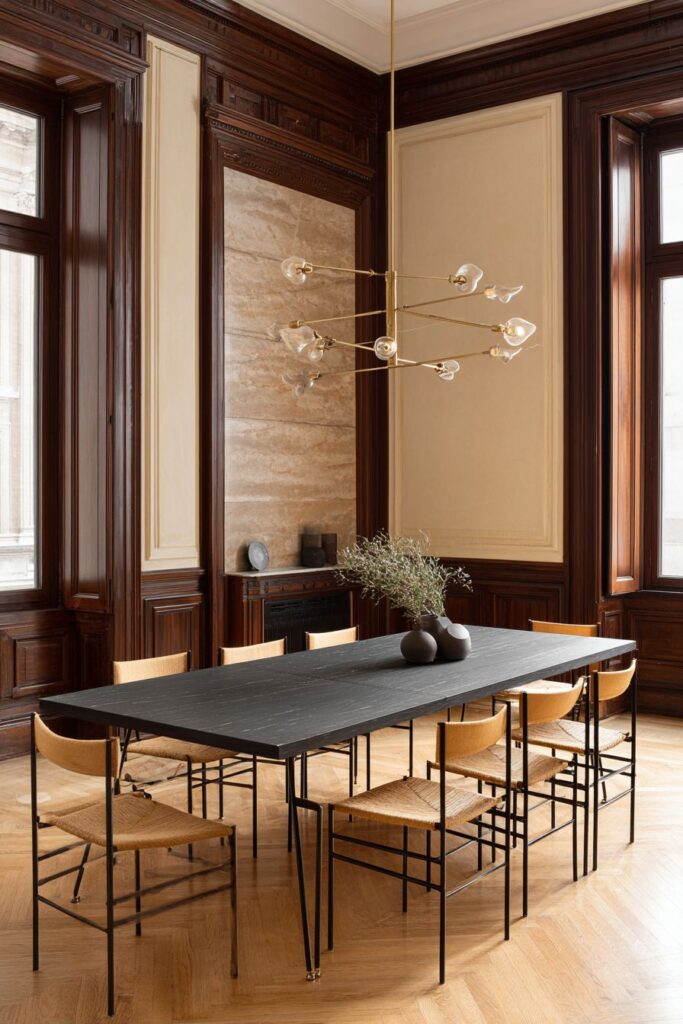
Key Design Tips:
- Balance dark wood finishes with light-colored walls for optimal contrast
- Incorporate traditional craftsmanship like rush seating for natural texture
- Use two-tone wall treatments to prevent wood paneling from overwhelming
- Choose multi-tiered chandeliers for sophisticated lighting hierarchy
- Select hairpin legs for structural innovation and visual lightness
16. Oval Tulip Elegance with Geometric Fabric Drama
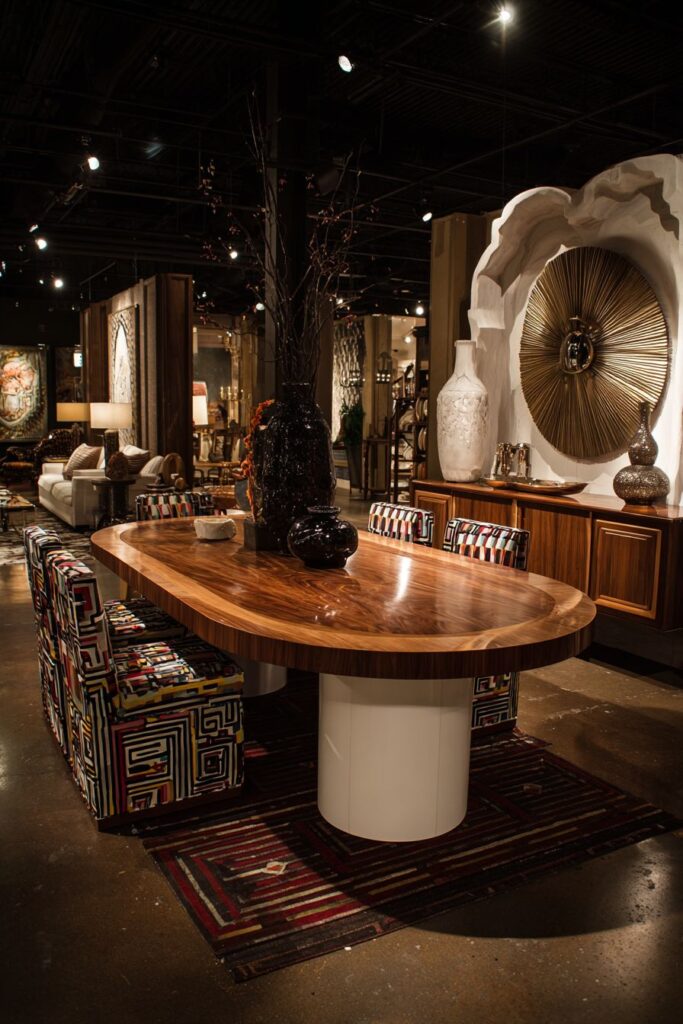
The sculptural beauty of tulip table design reaches sophisticated heights in this retro dining room featuring an oval dining table with the iconic white tulip base supporting a rich teak top. This design masterpiece represents the pinnacle of mid-century furniture innovation, where the sculptural base eliminates visual clutter while the oval shape promotes intimate conversation. The teak top adds natural warmth and grain beauty that contrasts beautifully with the pristine white base.
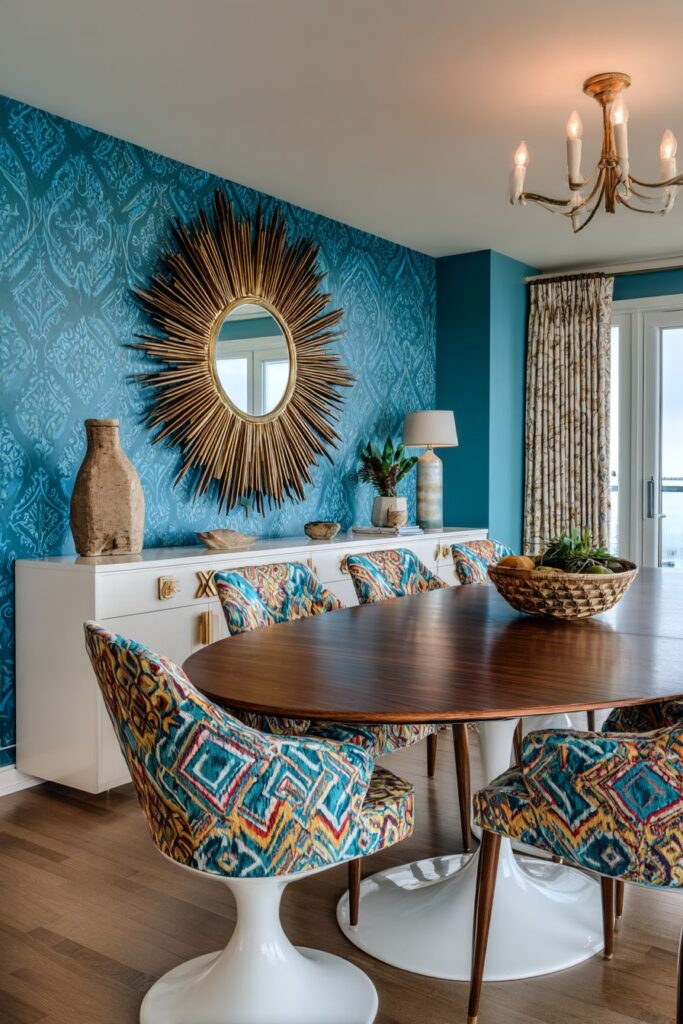
Upholstered side chairs in vibrant geometric fabric patterns create seating that functions as moveable art pieces, their bold patterns reflecting the atomic age’s fascination with molecular structures and mathematical precision. These fabrics, often featuring interconnected circles, atomic motifs, or angular geometries, transform functional seating into design statements that energize the entire space. The vibrant colors add personality while maintaining sophisticated restraint.

A dramatic sunburst mirror on the accent wall serves as sculptural art while amplifying light and creating the illusion of expanded space. This mirror design, with its radiating metal spikes or wooden rays, captures the atomic age’s fascination with energy and movement. The sunburst motif appears throughout mid-century design as a symbol of optimism and technological progress.
A low credenza in matching teak with distinctive hardware provides storage while maintaining visual continuity with the dining table. The low profile prevents the piece from competing with the dramatic mirror while the matching teak finish creates design cohesion. Warm incandescent lighting creates subtle shadows and highlights that enhance the room’s sophisticated material palette and geometric elements.
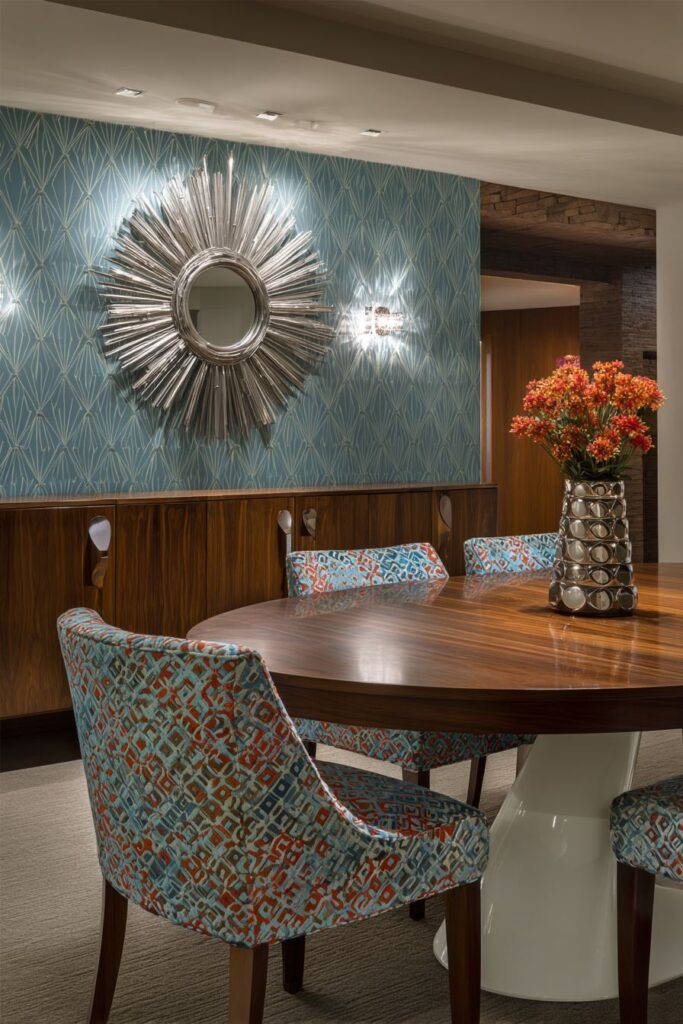
Key Design Tips:
- Choose oval tulip tables for sophisticated sculptural presence and conversation promotion
- Use geometric fabric patterns for seating that functions as moveable art
- Install sunburst mirrors for dramatic wall art that amplifies light
- Select matching wood finishes for furniture cohesion and visual flow
- Create warm lighting schemes that enhance natural wood grain and geometric elements
17. Compact Rainbow Charm with Grasscloth Sophistication
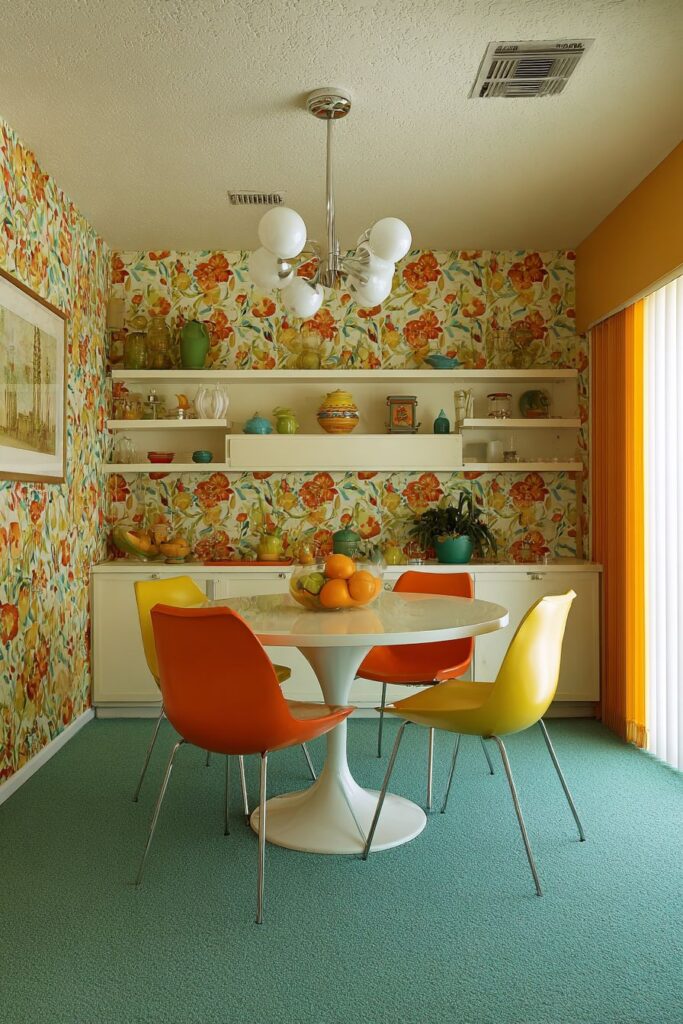
The cheerful optimism of mid-century design bursts forth in this retro dining room featuring a compact round dining table with pedestal base in chrome and white that maximizes functionality while minimizing visual weight. The round shape promotes democratic dining where all guests enjoy equal status, while the pedestal base eliminates traditional legs for improved traffic flow and visual openness. The chrome and white combination reflects the space-age aesthetics that defined the era.
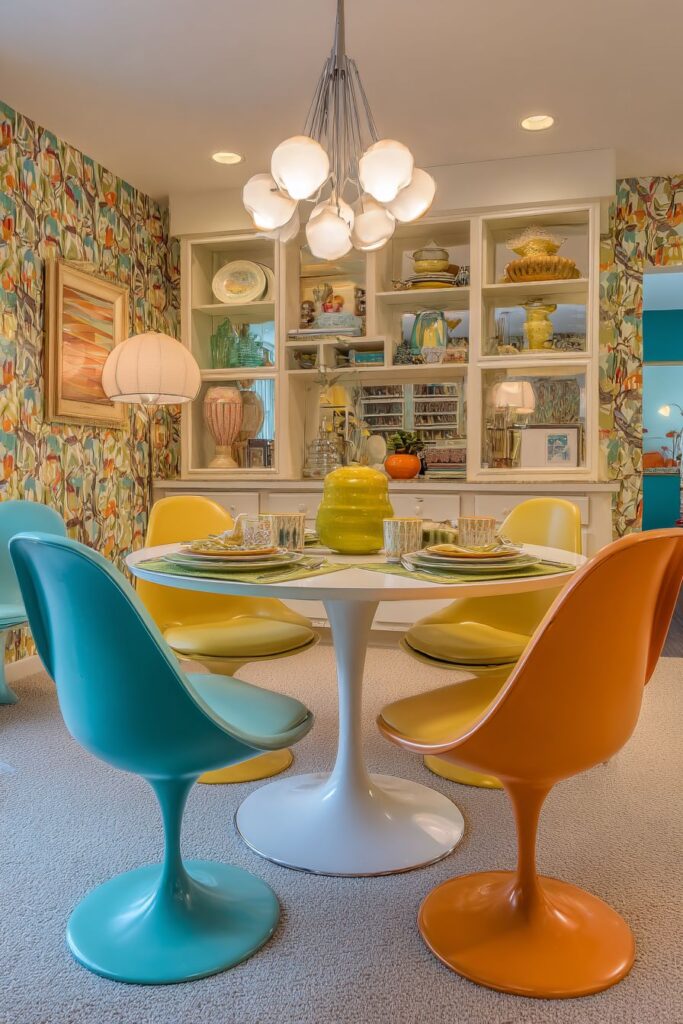
Molded plastic chairs in a rainbow of retro colors including orange, yellow, and turquoise surround the table, creating a celebration of color that embodies the period’s optimistic worldview. These chairs demonstrate the revolutionary manufacturing processes that made sophisticated design accessible to broader audiences while their bright colors inject joy and energy into the dining experience. The rainbow array creates visual movement and prevents monotony.

Grasscloth wallpaper provides sophisticated texture and natural material contrast to the bright plastic furniture, adding organic warmth that balances the synthetic materials. The woven texture of grasscloth creates subtle pattern and visual interest while its neutral tones allow the colorful furniture to take center stage. This material choice reflects the period’s appreciation for natural textures even within high-tech environments.
Built-in shelving displays vintage ceramics and glassware, creating functional storage that doubles as decorative display space. These integrated storage solutions maintain the period’s preference for clean lines and minimal visual clutter while providing practical storage for dining essentials. A multi-bulb pendant fixture provides even lighting that eliminates harsh shadows and creates welcoming ambiance for dining.
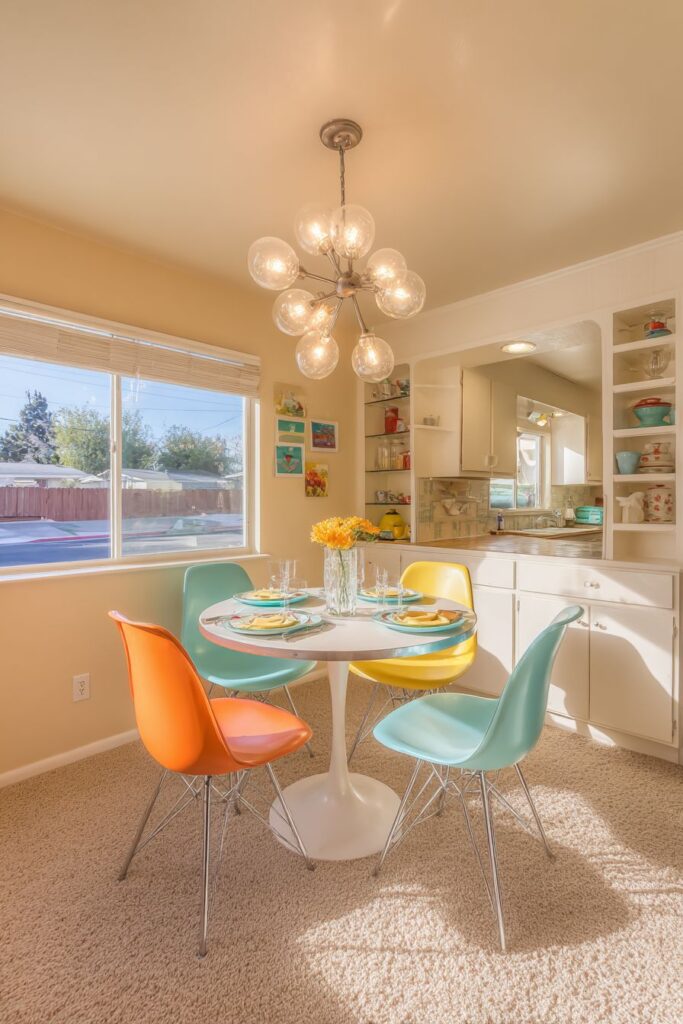
Key Design Tips:
- Use round pedestal tables in small spaces for maximum functionality and visual openness
- Create rainbow color schemes with molded plastic chairs for cheerful energy
- Balance synthetic materials with natural grasscloth wallpaper for textural contrast
- Install built-in shelving for integrated storage and display opportunities
- Choose multi-bulb fixtures for even lighting distribution without harsh shadows
18. Rosewood Luxury with Geometric Wood Treatment
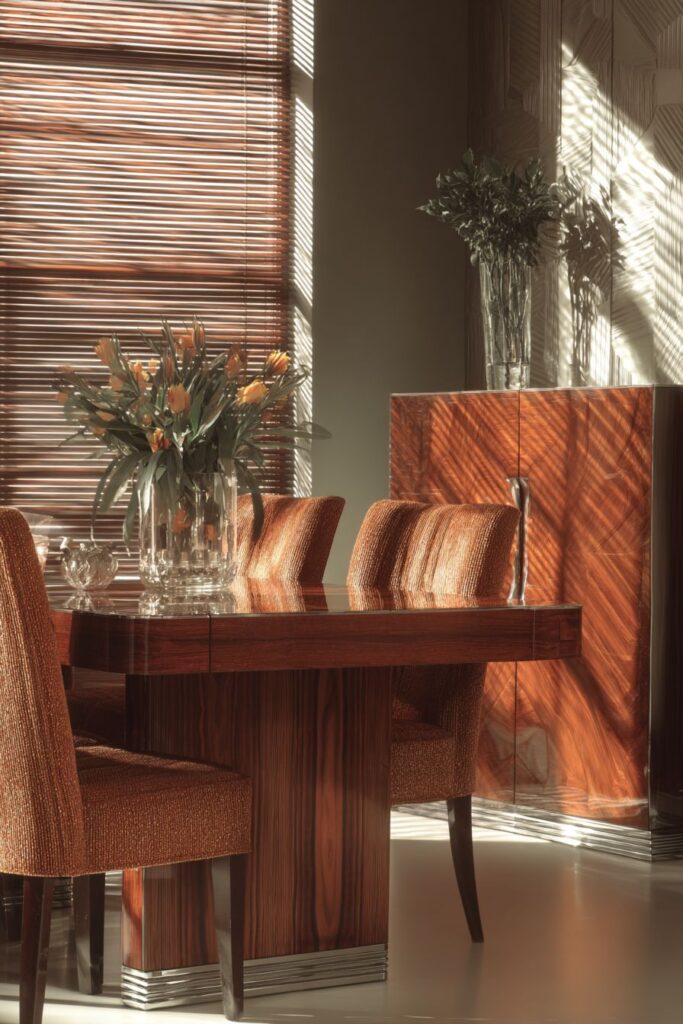
The luxury end of mid-century furniture design shines in this sophisticated retro dining room featuring a substantial rectangular dining table in rosewood with distinctive grain patterns and chrome accents. Rosewood, prized for its dramatic color variations and striking grain patterns, represents the premium materials that defined high-end mid-century furniture. The chrome accents provide contemporary contrast while highlighting the wood’s natural beauty through material juxtaposition.
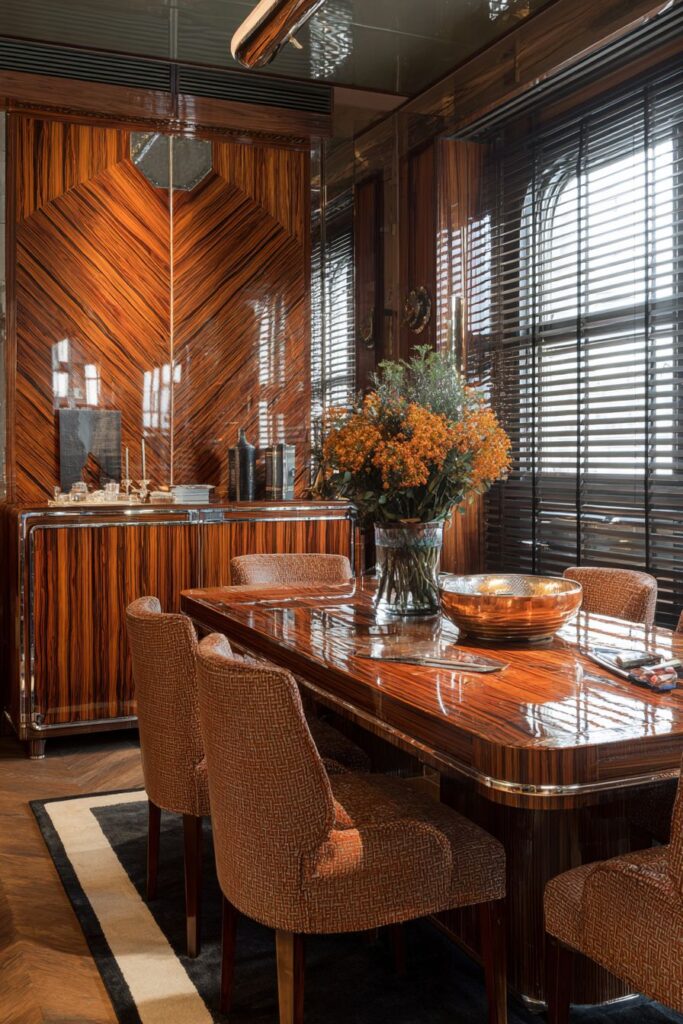
High-back dining chairs upholstered in textured fabric in warm earth tones surround this magnificent table, their generous proportions providing comfort while their rich upholstery adds luxury and visual warmth. The textured fabric creates tactile interest and visual depth while the earth tones complement the rosewood’s natural color variations. These chairs demonstrate the period’s commitment to both style and comfort in dining seating.
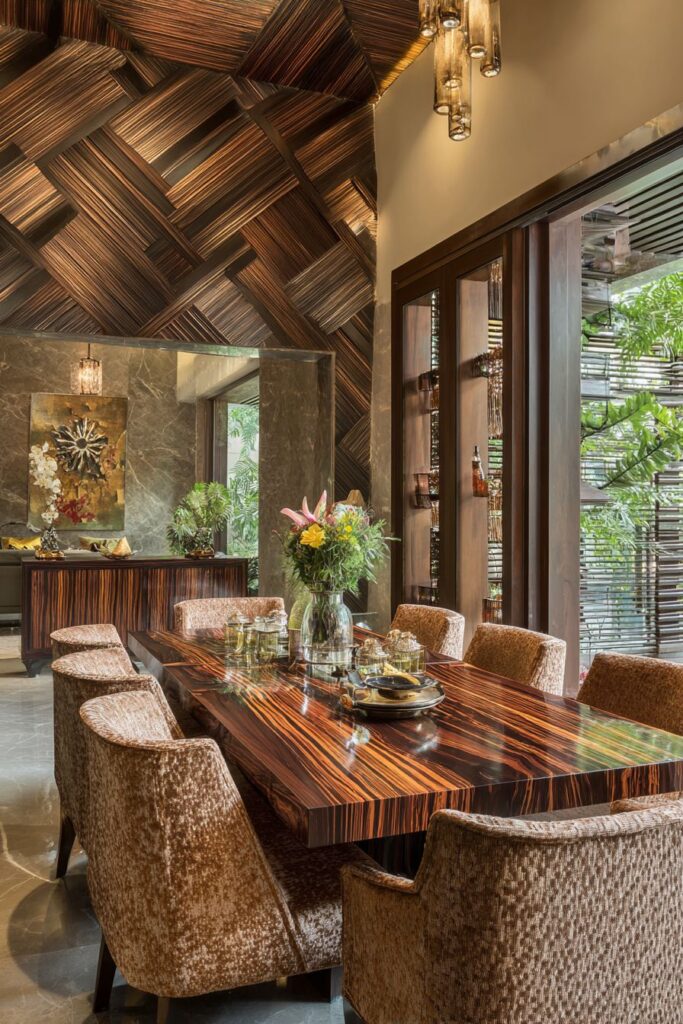
A feature wall with geometric wood treatment creates architectural drama while showcasing the period’s innovative approach to wall design and natural materials. This treatment, whether featuring wood planks in geometric arrangements or three-dimensional wooden elements, adds sculptural interest while maintaining the room’s connection to natural materials. The geometric precision reflects atomic age fascination with mathematical forms.
A vintage sideboard with sliding doors provides storage while demonstrating the period’s innovative approach to furniture functionality and space utilization. The sliding doors save space while maintaining clean lines, and the sideboard’s proportions complement the dining table without competing for visual attention. Natural light filtering through horizontal blinds creates interesting shadow patterns that enhance the wood grain and geometric elements.
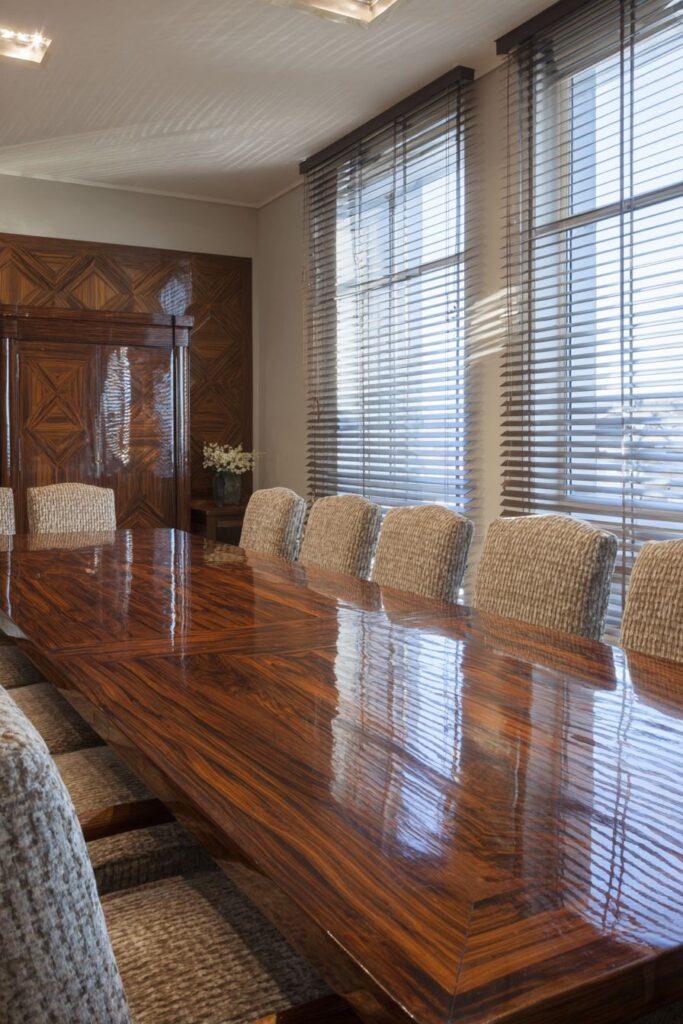
Key Design Tips:
- Invest in premium wood species like rosewood for dramatic grain and luxury appeal
- Choose textured upholstery fabrics in earth tones for comfort and visual richness
- Create geometric wood feature walls for architectural drama and natural material display
- Select furniture with sliding doors for space efficiency and clean aesthetic lines
- Use horizontal blinds to create interesting shadow patterns that enhance wood grain
19. Atomic Age Chrome with Cognac Leather Luxury
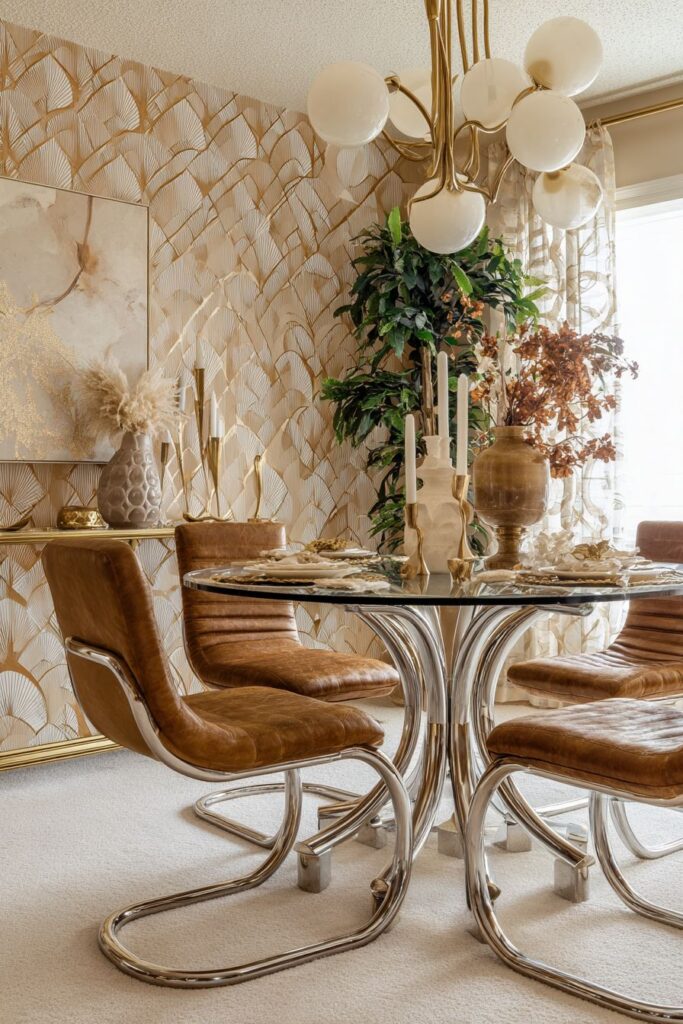
The sophisticated glamour of atomic age design reaches its zenith in this retro dining room featuring a glass-top dining table with a sculptural chrome base inspired by atomic age motifs. This table represents the period’s fascination with scientific discovery and space exploration, where the chrome base mimics molecular structures or atomic formations while supporting a crystal-clear glass top. The transparency of the glass maintains visual openness while the sculptural base creates dramatic focal interest.
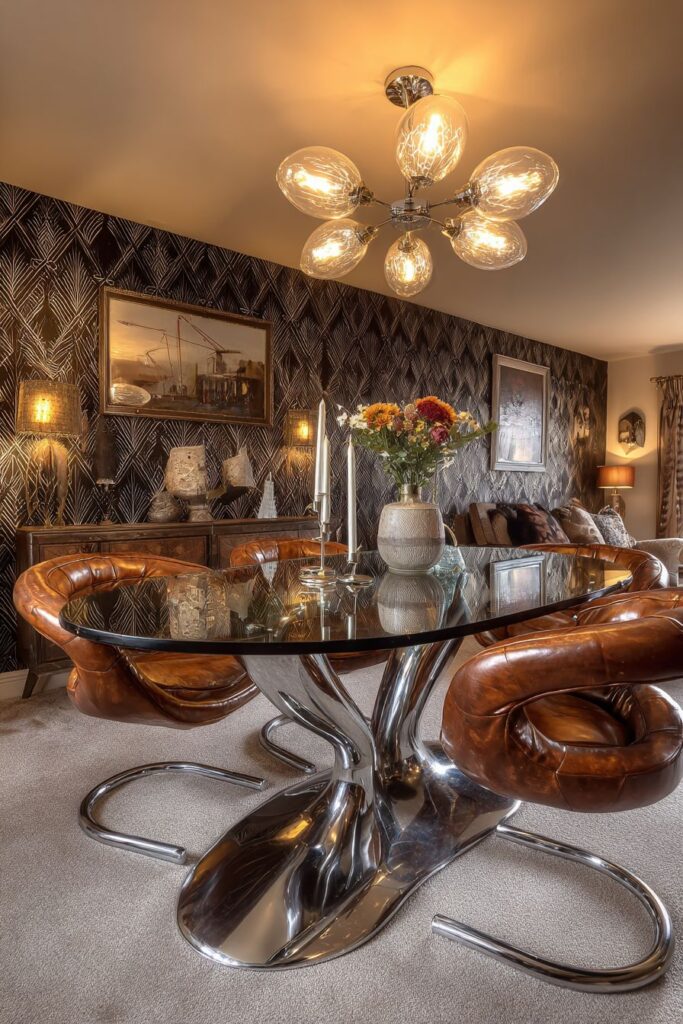
Cantilever chairs with leather upholstery in rich cognac brown surround this masterpiece, their floating appearance creating visual drama while the premium leather adds luxury and develops beautiful patina over time. The cantilever design eliminates rear legs for a gravity-defying appearance that was revolutionary when introduced, while the cognac leather provides warmth and sophisticated color that complements the cool chrome and glass materials.
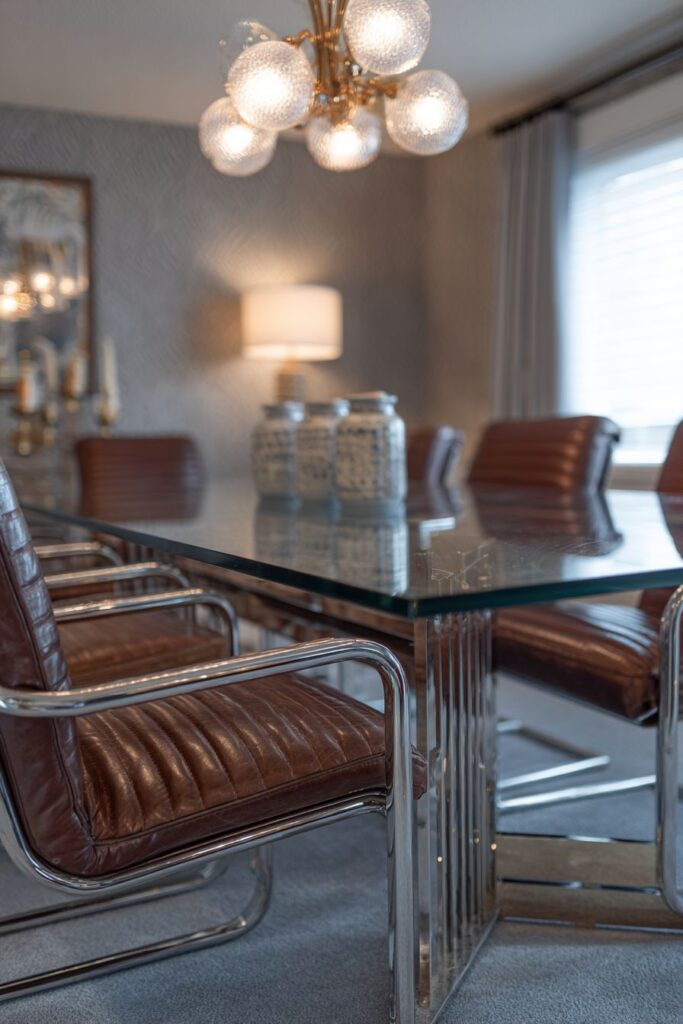
Bold geometric wallpaper creates a striking backdrop that captures the era’s love of mathematical precision and atomic-age motifs, featuring patterns that often include interconnected circles, molecular structures, or space-age geometries. These patterns transform the wall into a large-scale art installation while maintaining the sophisticated restraint that defines quality mid-century design. The bold graphics energize the space without overwhelming the sophisticated furniture.
Vintage accessories including ceramic vessels and brass candlesticks create curated vignettes that reflect the period’s appreciation for both functional objects and decorative arts. These accessories, often featuring atomic-age forms or space-age aesthetics, add personality while maintaining design cohesion. A statement chandelier with multiple frosted glass globes provides ambient lighting that diffuses evenly throughout the space while creating a constellation effect above the dining table.
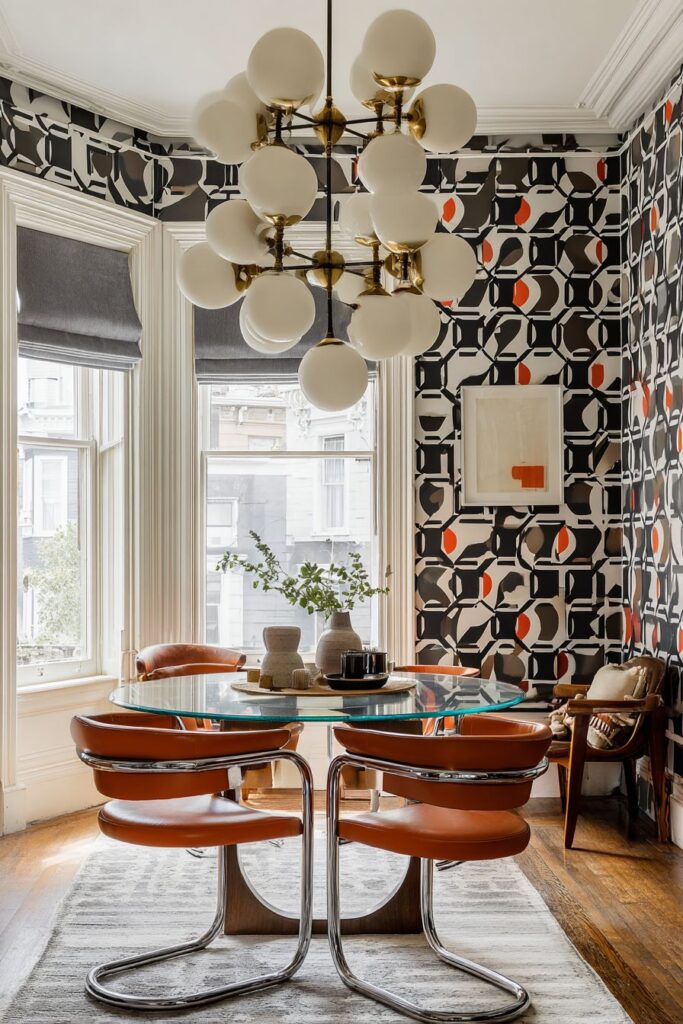
Key Design Tips:
- Choose sculptural chrome bases that reflect atomic age scientific fascination
- Use cantilever chairs for dramatic floating appearance and space-age appeal
- Select bold geometric wallpaper that functions as large-scale wall art
- Display vintage accessories that reflect atomic age forms and space exploration themes
- Install chandeliers with multiple globes for constellation lighting effects
20. Butterfly-Leaf Functionality with Burnt Orange Warmth
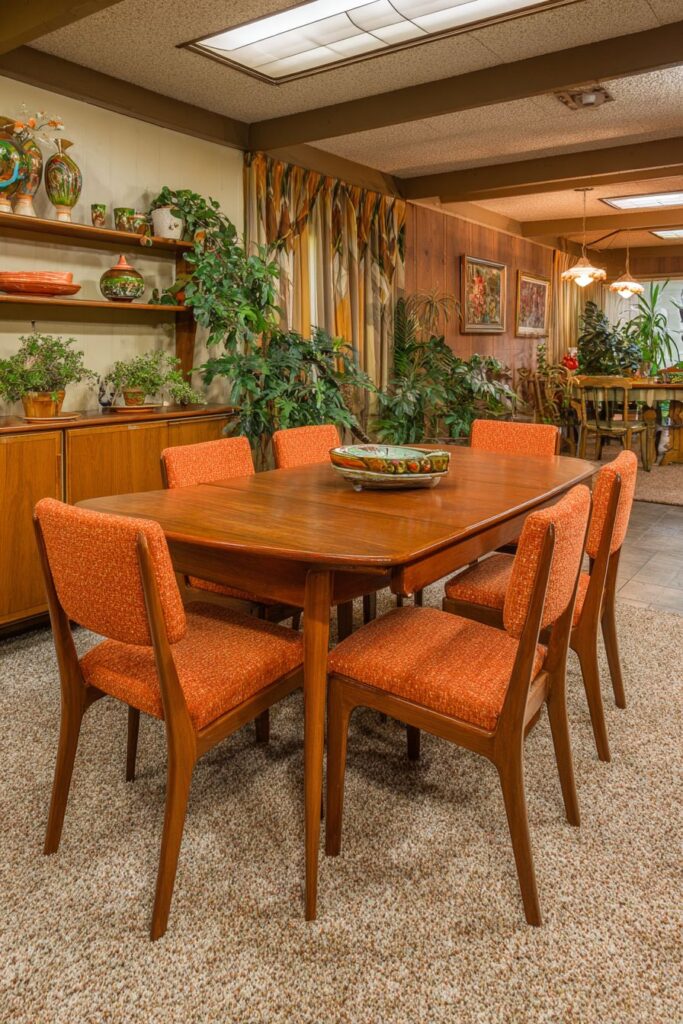
The practical genius of mid-century furniture design comes alive in this retro dining room featuring a unique butterfly-leaf dining table in rich walnut with elegant tapered legs, shown in its expanded configuration with the extension leaf visible. This design showcases the period’s commitment to functional flexibility, where the butterfly-leaf mechanism allows the table to accommodate varying numbers of diners while maintaining structural integrity and aesthetic appeal. The walnut finish provides warmth and natural beauty that improves with age.
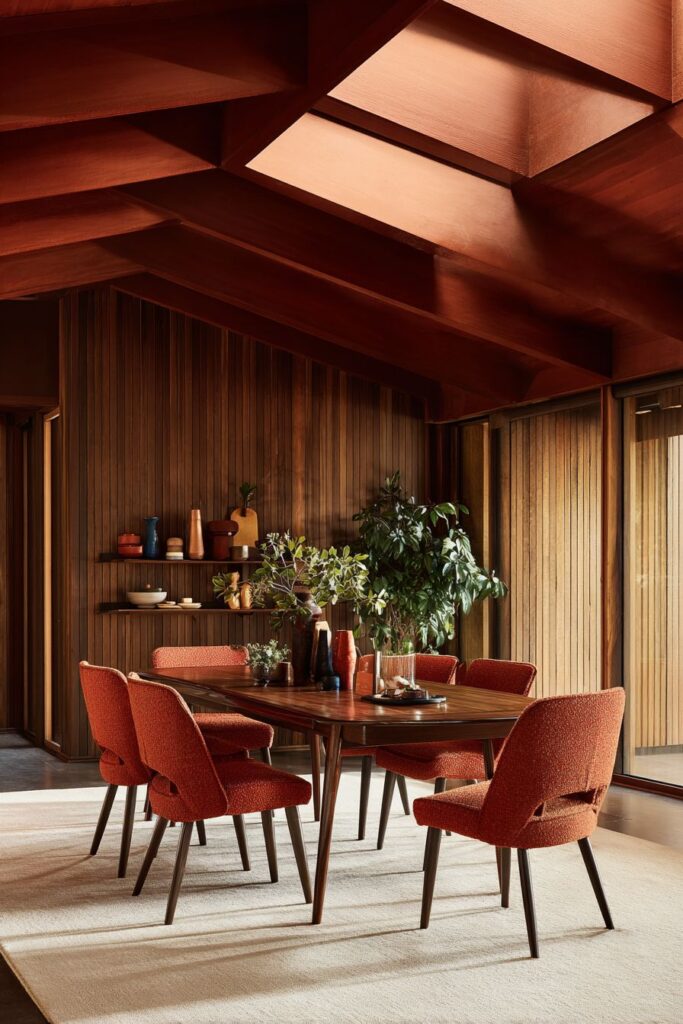
Six dining chairs featuring curved backs and textured upholstery in burnt orange surround this versatile table, their curved forms providing ergonomic comfort while creating visual rhythm around the expanded table. The burnt orange upholstery, an iconic color of the retro period, adds warmth and energy while the textured fabric provides tactile interest and visual depth. These chairs demonstrate the period’s mastery of combining comfort with sophisticated styling.
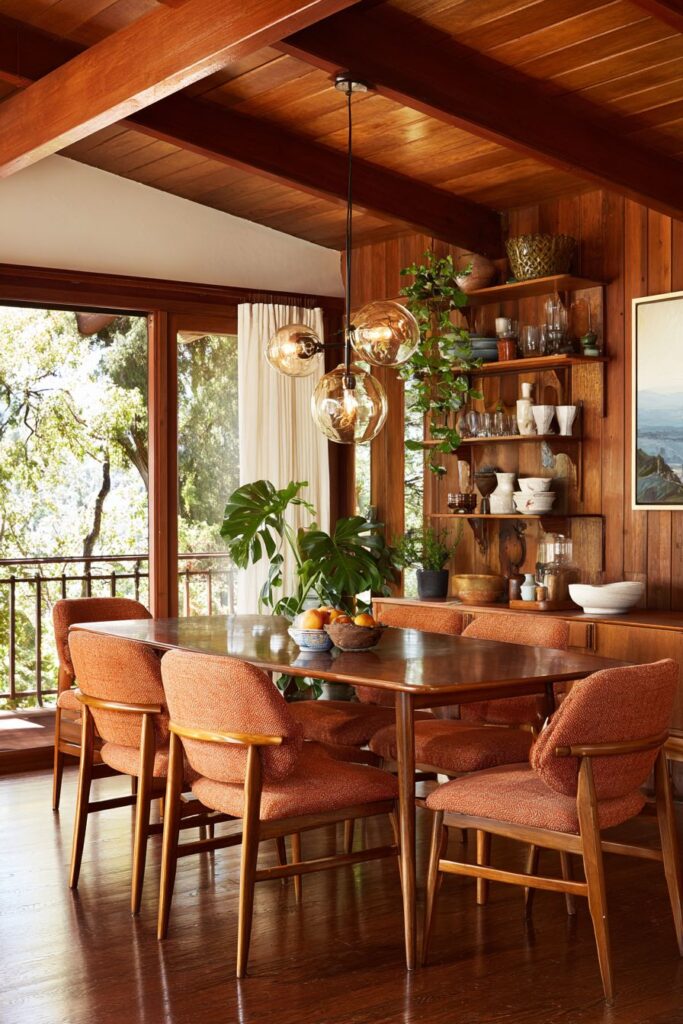
A wood-paneled accent wall creates architectural interest and natural material focus that enhances the room’s connection to organic materials and traditional craftsmanship. The wood paneling adds warmth and texture while creating a backdrop that complements rather than competes with the furniture’s rich finishes. This treatment reflects the period’s appreciation for natural materials even within modern design contexts.
Floating shelves displaying period-appropriate serving pieces create functional storage while showcasing the era’s distinctive dinnerware and decorative objects. These shelves maintain the period’s preference for clean lines and minimal visual weight while providing practical storage for dining essentials. Natural daylight from clerestory windows highlights the rich wood tones and creates dramatic lighting effects that change throughout the day, emphasizing the authentic materials and sophisticated color palette.
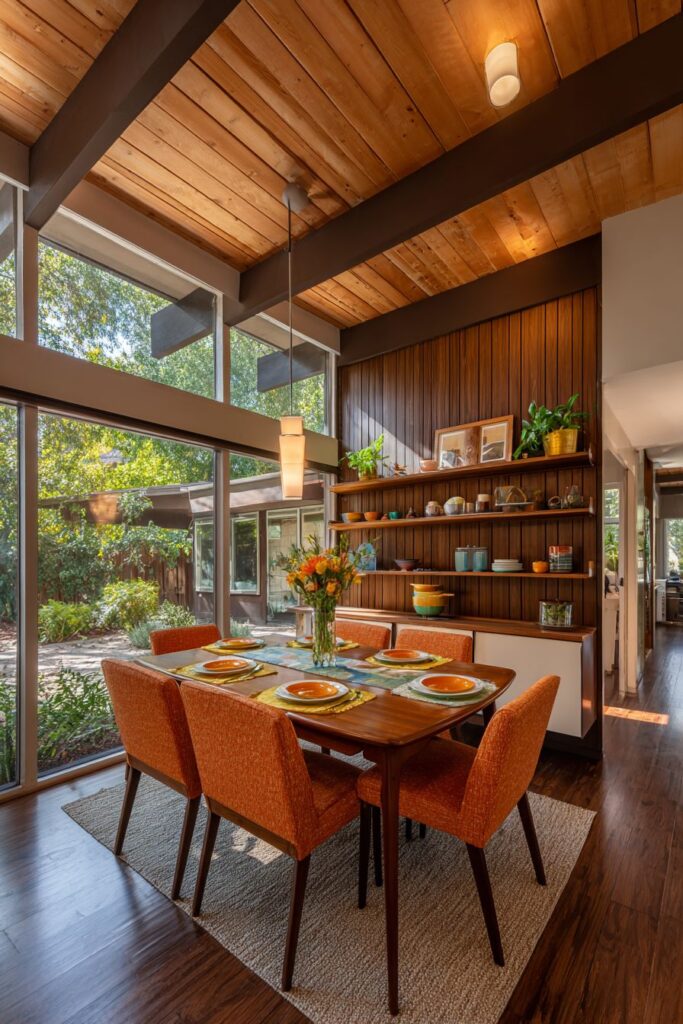
Key Design Tips:
- Choose butterfly-leaf tables for functional flexibility and space optimization
- Use curved chair backs for ergonomic comfort and visual rhythm creation
- Create wood-paneled accent walls for natural material focus and architectural interest
- Display period-appropriate serving pieces on floating shelves for functional decoration
- Install clerestory windows for dramatic natural lighting that highlights wood grain
Why These Retro Dining Room Designs Represent the Best of Mid-Century Style
These twenty retro dining room designs showcase the fundamental principles that make mid-century modern style timelessly appealing and endlessly relevant. Each design demonstrates the period’s core philosophy of combining functional innovation with aesthetic sophistication, creating spaces that serve practical needs while elevating the dining experience through thoughtful design choices. The emphasis on quality materials like teak, walnut, and rosewood ensures these pieces develop character and beauty over time, making them investments in both style and substance.
The integration of innovative materials such as molded fiberglass, chrome, and vinyl represents the democratization of good design that defined the mid-century period. These materials, born from wartime technological advances, allowed sophisticated styling to reach broader audiences while introducing new possibilities for color, form, and function. The bold color palettes featuring burnt orange, avocado green, and turquoise reflect the era’s optimistic worldview and confidence in the future, creating dining spaces that energize and inspire.
The furniture forms showcased in these designs—from tulip tables to cantilever chairs to sculptural bases—represent breakthrough thinking in structural engineering and aesthetic innovation. These pieces solved practical problems while creating visual drama, demonstrating that functional design need not sacrifice beauty. The emphasis on geometric patterns and atomic-age motifs reflects the period’s fascination with scientific discovery and space exploration, creating design elements that capture the excitement and optimism of their time.
The lighting solutions featured throughout these designs, from Sputnik chandeliers to atomic-era pendants to multi-tiered fixtures, showcase the period’s understanding that lighting serves both functional and aesthetic purposes. These fixtures provide adequate illumination for dining while creating sculptural focal points that enhance the room’s overall design impact. The integration of natural lighting through clerestory windows and horizontal blinds demonstrates the period’s commitment to connecting indoor and outdoor environments.
The storage solutions presented in these designs—from Danish credenzas to built-in shelving to rolling bar carts—reflect the period’s innovative approach to organization and display. These pieces maintain clean aesthetic lines while providing practical storage, often incorporating innovative mechanisms like sliding doors or tambour fronts that save space while maintaining visual appeal. The emphasis on displaying vintage ceramics, glassware, and serving pieces creates opportunities for personal expression within the overall design framework.
Conclusion
The enduring appeal of retro dining rooms lies in their perfect balance of innovation and timelessness, functionality and beauty, industrial materials and natural warmth. These twenty designs demonstrate that mid-century modern style continues to resonate with contemporary homeowners because it addresses fundamental human needs for both practical functionality and aesthetic inspiration. The clean lines, quality materials, and thoughtful proportions create environments that feel both sophisticated and welcoming, formal enough for special occasions yet comfortable enough for everyday family dining.
Whether you’re drawn to the sculptural drama of a tulip table, the warm richness of teak furniture, the playful energy of colorful molded chairs, or the geometric precision of atomic-age patterns, these retro dining room concepts offer countless opportunities for creating spaces that honor the past while remaining perfectly relevant for contemporary living. The key to successful retro dining room design lies in understanding the underlying principles that made mid-century modern style so revolutionary—the commitment to quality, the embrace of innovation, and the belief that good design can improve daily life.
As you consider incorporating these ideas into your own home, remember that the best retro dining rooms combine authentic period pieces with contemporary functionality, creating spaces that capture the spirit of mid-century optimism while serving the practical needs of modern families. Start with one or two key pieces—perhaps a distinctive table or iconic chairs—and build your design around these anchors, adding color, pattern, and accessories that reflect your personal style while honoring the sophisticated restraint that defines the best of retro design.
